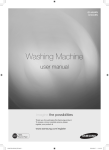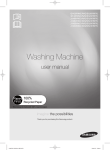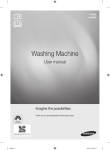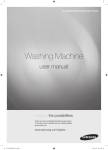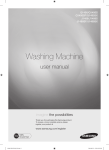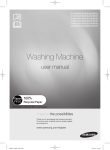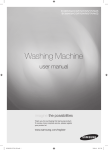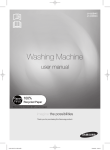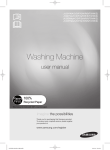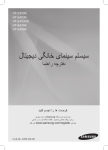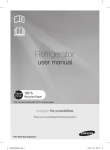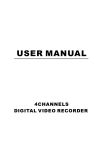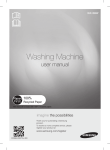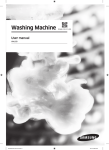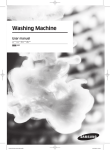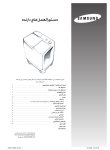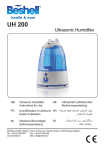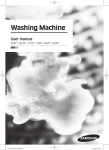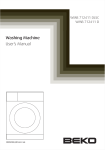Download Samsung WA3/HC راهنمای محصول
Transcript
WA3 Washing machine User manual This manual is made with 100 % recycled paper. Imagine the possibilities Thank you for purchasing this Samsung product. DC68-03481A-01 Untitled-8 1 2014-11-26 5:08:26 Content 3 Safety information Icons and symbols used in this manual . . . . . . . . . . . . . . . . . . . . . . . . . . . . . . . . . . . . . . . . . . 3 Important safety instructions . . . . . . . . . . . . . . . . . . . . . . . . . . . . . . . . . . . . . . . . . . . . . . . . . . 5 Location requirements. . . . . . . . . . . . . . . . . . . . . . . . . . . . . . . . . . . . . . . . . . . . . . . . . . . . . . . 6 7 Installation What's included. . . . . . . . . . . . . . . . . . . . . . . . . . . . . . . . . . . . . . . . . . . . . . . . . . . . . . . . . . . . 7 Installation requirements. . . . . . . . . . . . . . . . . . . . . . . . . . . . . . . . . . . . . . . . . . . . . . . . . . . . . . 8 Step-by-step installation. . . . . . . . . . . . . . . . . . . . . . . . . . . . . . . . . . . . . . . . . . . . . . . . . . . . . . 9 20 Basic operations Laundry guidelines. . . . . . . . . . . . . . . . . . . . . . . . . . . . . . . . . . . . . . . . . . . . . . . . . . . . . . . . . 20 Detergent types and usage . . . . . . . . . . . . . . . . . . . . . . . . . . . . . . . . . . . . . . . . . . . . . . . . . . 23 When to add fabric softener. . . . . . . . . . . . . . . . . . . . . . . . . . . . . . . . . . . . . . . . . . . . . . . . . . 23 Handling the secure door. . . . . . . . . . . . . . . . . . . . . . . . . . . . . . . . . . . . . . . . . . . . . . . . . . . . 23 About a sanitizing wash. . . . . . . . . . . . . . . . . . . . . . . . . . . . . . . . . . . . . . . . . . . . . . . . . . . . . 24 Getting started. . . . . . . . . . . . . . . . . . . . . . . . . . . . . . . . . . . . . . . . . . . . . . . . . . . . . . . . . . . . 25 29 Maintainence Cleaning the exterior. . . . . . . . . . . . . . . . . . . . . . . . . . . . . . . . . . . . . . . . . . . . . . . . . . . . . . . . 29 Keeping the tub clean . . . . . . . . . . . . . . . . . . . . . . . . . . . . . . . . . . . . . . . . . . . . . . . . . . . . . . 29 Cleaning the water valve mesh filter. . . . . . . . . . . . . . . . . . . . . . . . . . . . . . . . . . . . . . . . . . . . 30 Filter. . . . . . . . . . . . . . . . . . . . . . . . . . . . . . . . . . . . . . . . . . . . . . . . . . . . . . . . . . . . . . . . . . . . 31 32 Troubleshooting Check the table below for basic troubleshooting solutions. . . . . . . . . . . . . . . . . . . . . . . . . . . 32 Information codes . . . . . . . . . . . . . . . . . . . . . . . . . . . . . . . . . . . . . . . . . . . . . . . . . . . . . . . . . 34 35 Specifications Specifications. . . . . . . . . . . . . . . . . . . . . . . . . . . . . . . . . . . . . . . . . . . . . . . . . . . . . . . . . . . . . 35 English - 2 Untitled-8 2 2014-11-26 5:08:26 Safety information SAFETY INFORMATION Throughout this manual, you’ll see Warning and Caution symbols. These warnings, cautions, and the important safety instructions that follow do not cover all possible conditions and situations that may occur. The product you have purchased is designed for domestic use only. Using the product for business purposes qualifies as a product misuse. In this case, the product will not be covered by the standard warranty provided by Samsung and no responsibility will be attributed to Samsung for malfunctions or damages resulting from such misuse. It’s your responsibility to use common sense and caution when installing, maintaining, and operating your washing machine. Samsung is not liable for damages resulting from improper use. After reading this manual, store it in a safe place for future reference. Icons and symbols used in this manual These warning signs are here to prevent injury to yourself and others. Please follow them explicitly. WARNING: Hazards or unsafe practices that may result in severe physical injury, death and/or property damage. CAUTION: Hazards or unsafe practices that may result in physical injury and/or property damage. NOTE Read all instructions before using the appliance. As with any equipment that uses electricity and moving parts, potential hazards exist. To safely operate this appliance, familiarize yourself with its operation and exercise care when using it. English - 3 Untitled-8 3 2014-11-26 5:08:27 Do not let children (or pets) play in or on your washing machine. The washing machine door does not open easily from the inside and children may be seriously injured if trapped inside. This appliance is not to be used by persons (including children) with reduced physical, sensory or mental capabilities, or lack of experience and knowledge, unless they have been given supervision or instruction concerning use of the appliance by a person responsible for their safety. Children should be supervised to ensure that they do not play with the appliance. For use in Europe: This appliance can be used by children aged from 8 years and above and persons with reduced physical, sensory or mental capabilities or lack of experience and knowledge if they have been given supervision or instruction concerning use of the appliance in a safe way and understand the hazards involved. Children shall not play with the appliance. Cleaning and user maintenance shall not be made by children without supervision. If the supply cord is damaged, it must be replaced by the manufacturer, its service agent or similarly qualified persons in order to avoid a hazard. This appliance should be positioned so that the power plug, the water supply taps, and the drain pipes are accessible. For appliances with ventilation openings in the base, that a carpet must not obstruct the openings. The new hose-sets supplied with the appliance are to be used and that old hose-sets should not be reused. English - 4 Untitled-8 4 2014-11-26 5:08:27 SAFETY INFORMATION CAUTION: In order to avoid a hazard due to inadvertent resetting of the thermal cut-out, this appliance must not be supplied through an external switching device, such as a timer, or connected to a circuit that is regularly switched on and off by the utility. Important safety instructions WARNING: For safety reasons, read through the following instructions before installing or using the washing machine. Do not attempt to repair, disassemble, or modify your washing machine. For any repairs, contact your nearest Samsung service center. Do not wash items contaminated with gasoline, kerosene, solvents, or any other flammable substances. Do not install the washing machine in a location exposed to extreme temperatures, high-humidity levels, and/or the weather. Do not let children or pets play in, on, or around the washing machine. Proper supervision is necessary at all times. Do not use the washing machine if the washing machine or any parts of the washing machine are damaged. Keep all packaging materials away from children. Do not put your hands or any objects in or under the washing machine while the washing machine is operating. Do not replace a damaged power cord or power plug yourself. Have Samsung or a qualified service technician replace a damaged power cord or power plug. Before disposing of your washing machine, remove the lid. English - 5 Untitled-8 5 2014-11-26 5:08:27 Location requirements To ensure safe and proper installation and use of your washing machine, follow these guidelines for selecting a location. WARNING: • Use caution when lifting or moving the washing machine. • Do not install the washing machine in areas exposed to the weather. • Do not install the washing machine in areas where the ambient temperature may drop below 32 °F (0 °C). • Keep the washing machine away from electrical devices. • Do not install the washing machine in a location where gas may leak. • Do not install the washing machine near a heater or flammable material. Select a level, well-constructed surface that does not have carpeting or flooring that may obstruct ventilation or contribute to vibrations. Select a location where a grounded, 3-prong socket is easily accessible. For the provided water hoses to reach the washing machine, make sure the water taps are within 120 cm (4 ft) of the back of the washing machine. English - 6 Untitled-8 6 2014-11-26 5:08:27 Installation INSTALLATION Follow these instructions carefully to ensure that the new washing machine works properly and to avoid physical injury. What's included Carefully unpack the washing machine, and make sure you’ve received all the parts shown below. If the washing machine was damaged during delivery, or if you do not have all the parts, contact a local Samsung customer service center or your Samsung retailer. 6 7 1 2 3 8 4 1 Door lid 2 Secure door lid 3 Filter 4 Tub 5 Levelling feet 6 Cold water supply hose 7 Hot water supply hose (applicable models only) 8 Drain hose 9 Power cord 10 Baffle board 9 10 5 This product can only be used with 220 V, and is not compatible with a power source of 110 V. Accessories The water supply hose and the drain hose (extension hose) can be purchased at a local Samsung service center. Water supply hose (2) Drain hose Hose guide Drain adaptor Clamper Baffle board Leveling device Screw User manual Inlet T adaptor English - 7 Untitled-8 7 2014-11-26 5:08:28 Installation requirements Water Supply • The washing machine fills up with a water pressure of 0.05 Mpa ~ 0.78 Mpa (0.5~8.0 kg•f/ cm2). • A water pressure level of less than 0.05 MPa (0.5 kg•f/cm2) may inhibit the water valve to close completely. Or it may take longer than normal to fill the washing machine, causing the washing machine to turn off. (The washing machine has a fill-time limit that is designed to prevent an overflow against a loose internal hose) • For the provided water hoses to reach the washing machine, make sure the water taps are within 120 cm (4 ft) of the back of the washing machine. • Before using for the first time, check all connections at the water valves and taps for any leaks. To reduce a risk of water leaks: • Make sure the water taps are easily accessible. • Turn off the water taps when the washing machine is not in use. • Check for any water leaks at the water inlet hose fittings. Power supply • To prevent a risk of fire, electrical shock, or physical injury, all wiring and grounding must be performed in accordance with the National Electrical Code ANSI/FNPA, No. 70 Latest Revision and local codes and ordinances. It is the owner's responsibility to accommodate adequate electrical power for this product. • Do not use an extension cord. • Use only the power cord that comes with your washing machine. • When preparing for installation, ensure that your power supply offers: • A fuse or circuit breaker • An individual branch circuit serving only your washing machine • The washing machine must be properly grounded. Against a malfunction or breakdown of the machine, a proper grounding will reduce the risk of electric shock by providing minimum resistance to the electric current. • The washing machine comes with a power cord that has a three-prong grounding plug for use in a properly installed and grounded socket. • Do not connect the ground wire to plastic plumbing lines, gas lines, or hot water pipes. • Improper connection of the grounding conductor may cause electric shock. Check with a qualified electrician or service person if the washing machine is properly grounded. • Do not modify the plug that comes with the washing machine. If it does not fit the socket, have a proper socket installed by a qualified electrician. English - 8 Untitled-8 8 2014-11-26 5:08:28 Grounding INSTALLATION For safety, the washing machine must be grounded. • Ensure that the washing machine is properly grounded to prevent electric shock. If the wall socket has a ground terminal No additional grounding is required. (*): Ground terminal Step-by-step installation Step 1 - Select a location Location requirements: • On a solid, even surface without carpeting or flooring. • Allowing at least 10 cm (4 inches) of distance between the washing machine and the wall. • Not exposed to direct sunlight or rain as moisture may damage the electrical insulation, causing an electrical shock hazard. • Require adequate ventilation. • Not exposed to temperatures below 32 °F or 0 °C. • Away from a heat source. • enough space so that the washing machine doesn’t stand on its power cord. English - 9 Untitled-8 9 2014-11-26 5:08:28 Step 2 - Connect the water supply hose 1. Connect the L-shaped arm fitting for the cold water supply hose to the cold water supply intake at the upper rear side of the washing machine. Then tighten it by turning part (A) clockwise by hand. (*): applicable models only A 2. Remove the adaptor (B) from the other end of the water supply hose (C). B C 3. Loosen the four screws on the adaptor using a Philips screwdriver. 4. Connect the adaptor to the water tap by tightening all the screws firmly while lifting the adaptor upwards. 5. Connect the water supply hose to the adaptor. If you push part (D) into the adaptor, the hose automatically connects to the adaptor with a clicking sound. After connecting the water supply hose to the adaptor, ensure that it is connected correctly by pulling the water supply hose downwards. D WARNING: Check if the water supply hose is not twisted or bent. If the hose is twisted or bent, water may leak, causing electric shock. If necessary, straighten the water supply hose by loosening the L-shaped arm fitting, rotating the hose, and retightening the L-shaped arm fitting. English - 10 Untitled-8 10 2014-11-26 5:08:29 INSTALLATION 6. Open the water tap and ensure that no water leaks from the water supply intake, water tap or adaptor. If you encounter a water leak, repeat the steps above. WARNING: In case of a water leak, stop using the washing machine. Otherwise, this may result in electric shock. If the water tap is of the screw type, connect the water supply hose to the tap as shown. Use the most conventional type of tap for the water supply. If the tap is square or too big, remove the space ring before inserting the adaptor into the tap. To connect the hot water supply hose (applicable models only) 1. Connect the red L-shaped arm fitting for the hot water supply hose to the hot water supply intake at the upper rear side of the washing machine. Then tighten it by manually turning part (A) clockwise. 2. Connect the other end of the hot water supply hose to the hot water tap in the same way as you connected the cold water supply hose. A To use only cold water, use the Y-piece. English - 11 Untitled-8 11 2014-11-26 5:08:29 Combine with an existing washing machine by sharing one water tap 1. Disconnect the water supply hose (A) from the existing washing machine. A 2. Connect the inlet T adaptor (B) to the inlet hole (C) of the existing washing machine. B C 3. Connect the disconnected water supply hose (A) to the inlet T adaptor (B). A B 4. Connect the water supply hose (D) for the sanitizing washing machine to the inlet hole of the sanitizing washing machine. (*): applicable models only D 5. Connect the water supply hose to the inlet T adaptor as shown, and turn it clockwise to tighten. It fits with a clicking sound. (*): Rubber ring To avoid water leaks, make sure the rubber ring is secured around the T adaptor. CAUTION: When finishing washing the laundry, close the water tap. Otherwise, this may cause the following: • If the water tap is not closed or not connected properly, water may leak especially in winter. • If the water tap is not closed, the supplied water may freeze inside the water hose. • The water tap or hose could burst at a low temperature. English - 12 Untitled-8 12 2014-11-26 5:08:29 Step 3 - Connect the drain hose 1. Insert the joint ring (A) around the drain hose. INSTALLATION A 2. Connect one end of the drain hose into a drain hole, and join the other end of the drain hose into the drain outlet of the washing machine. 3. Tighten the drain hose by pushing the joint ring into the drain outlet. The length of the drain hose is adjustable so that it can be extended as required. Pump draining system (applicable models only) 1. Connect the drain hose (A) to the case pump outlet pipe with the hose tilted at a 2 o'clock angle. The drain hose goes over the case pump outlet pipe. Make sure that you connect the drain hose so that less than 1/3 rd (10 mm) of the pipe remains exposed. A 2. Clamp the drain hose using a joint ring (B). Make sure the joint ring is clamped with its two prongs facing the washer. B English - 13 Untitled-8 13 2014-11-26 5:08:30 3. Insert the clamper (C) at the end of the sponge. Make sure the clamper covers one end of the sponge. Make sure the sponge is tightened. A loose sponge may cause noise while the washing machine is operating. C 4. Insert the included screw through the screw hole in the clamper, then fix the screw to the hole on the rear right side of the frame. Tighten with a screwdriver. 5. Make sure the drain hose is tightened as shown. 6. Place the drain hose 60 cm – 90 cm (*) above the floor as shown. Make sure the end of the drain hose is not submerged by water. CAUTION: Once you have tightened the screw on the clamper, do not loosen it. Otherwise, water may leak while the washing machine operates. English - 14 Untitled-8 14 2014-11-26 5:08:30 To reverse the direction of the drain hose (applicable No Pump models only) INSTALLATION While pressing down the joint ring, disconnect the drain hose. Reverse the direction of the drain hose and repeat the steps above to connect again. Considerations on the drain hose • When extending the drain hose by connecting another hose, the total length cannot exceed 3 m (A). A • For a proper draining, ensure that the drain hose ends at lower than the water level. • Ensure that the drain hose spreads straight to the drain hole with no obstacles higher than 5 cm (B) in the way. B • Do not pass the drain hose through the bottom of the washing machine. English - 15 Untitled-8 15 2014-11-26 5:08:31 To share the drain hole with an existing washing machine (applicable No Pump models only) To share one drain hole with an existing washing machine, use the drain T adaptor. 1. Connect the drain hose (A) of the sanitizing washing machine to one end of the drain T adaptor (B). A 2. Insert the drain hose (C) of the existing washing machine in its drain adaptor (D). For a fully automatic washing machine, please skip steps 2 and 3, and go directly to step 4. B B C 3. Use cable ties to tighten the joint if loose. D C 4. Connect the drain hose (C) of the existing washing machine to the drain T adaptor (B). 5. Insert the drain T adaptor to the drain hole (E) as shown. E CAUTION • If the drain T adaptor does not fit in the drain hole, water may leak around the drain hole. • Ensure that the drain T adaptor covers the drain hole. English - 16 Untitled-8 16 2014-11-26 5:08:31 To share the drain hole with an existing washing machine (applicable Pump models only) 1. Connect the drain hose (A) of the sanitizing washing machine to the drain adaptor (B) as shown. 2. Insert the drain hose (C) of the existing washing machine into the drain adaptor (B) as shown. INSTALLATION To share one drain hole with an existing washing machine, use the drain T adaptor. C B A 3. Insert the drain adaptor to the drain hole (D) as shown. B D CAUTION • If the drain adaptor does not fit in the drain hole, water may leak around the drain hole. • Ensure that the drain adaptor covers the drain hole. English - 17 Untitled-8 17 2014-11-26 5:08:32 Step 4 - Level the washing machine 1. Choose a location with a minimum clearance of 4 in (10 cm) from the rear and side walls. 2. Attach the provided two levelling devices to the front and side, respectively. Then, check if the washing machine is level within tolerance. 3. If the washing machine is not level, adjust the leveling feet. 4. To check if the washing machine is stable, press any two diagonal corners of the washer. It is shakes, adjust the leveling feet. English - 18 Untitled-8 18 2014-11-26 5:08:32 Step 5 – Insert the baffle board INSTALLATION 1. Lay the washing machine down on its side. • Do not lay the washing machine down on its front or back. • While laying the washing machine down, be careful not to scratch the surface of the washing machine. 2. Insert the baffle board into the bottom of the washing machine along the guided line. • The baffle board can reduce the working noise. • Once the baffle board is installed, do not remove it unless necessary. WARNING: Do not reach under the washing machine by hand or with any metal objects while the washing machine is operating. This may cause a physical injury or electric shock. After installation is complete, run the Rinse+Spin cycle to make sure the washing machine works properly. English - 19 Untitled-8 19 2014-11-26 5:08:32 Basic operations Laundry guidelines Carefully read the following instructions to avoid machine problems or damage to clothing. Check the Care label on clothing before washing. • Do not overload the tub with laundry. Excessive laundry reduces the washing efficiency, and severely wears the laundry. Besides, the washing machine may cause creasing or wrinkling on the laundry. • When washing big, bulky items or a few smaller items that don’t fill the tub completely (for example, a rug, a pillow, stuffed toys, or one or two sweaters) add a few towels to improve the tumbling and spinning performance. • Check if there are any items that might be discolored. Apply a liquid detergent to a white towel and a garment, and strongly rub the two items with each other. Check if anyone is affected by the other one. • Special care is needed for scarves and imported clothes since they discolor easily. Check for stains or dirt. For stains, add some detergent to a cloth and rub the stains in one direction. Soil and dirt may rub against delicate garments, causing damage to the garments. • For a badly soiled item, first dust it off and then wash it. • Before washing the laundry, make sure that sleeves, collars, dress hems and pockets are pretreated by brushing them with detergent. Wrinkle-processed clothing made of wool should be specially treated by tying them together (using thread) before washing. Remove the thread after the clothes have dried. • Metal items on clothing may damage the tub and other laundry. Turn clothing with buttons and embroidered clothes inside out before washing them. Zip up all zippers. Otherwise, the spin basket may be damaged. • Clothing with long strings may become entangled with other items. Make sure to fix the strings before starting a wash. • Turn delicate items inside out before washing them. • Wash black clothing and cotton towels separately. If these are washed together, the towels may become stained. • Curtains, light garments, or blue jeans should not float. If they are floating, stop the washing machine by pressing the START/PAUSE button and press them down until they are soaked in the water. If the wash continues with floating clothing, it may damage both the laundry and the washing machine. CAUTION • Check all pockets before washing. • Hair pins and coins may damage the washing machine. • Check all pockets for metal items, and remove them before washing. English - 20 Untitled-8 20 2014-11-26 5:08:32 Do not wash BASIC OPERATIONS • Clothing that is easily disfigured even when simply soaking in water. • Neckties, brassieres, jackets, suits and coats that are made mostly of rayon and other kind of blended fabrics that can be easily disfigured (e.g. shrinkage and discoloration). • Wrinkle-processed, embossed, or resin processed products that are easily disfigured even when soaked in water. • Easily discolored products made of cotton and wool, wrinkled silk, leather products, leather accessory, leather ornamented clothes and its accessories. • Do not wash waterproof clothing (e.g. ski wear, diaper covers and mats/rugs). This may cause the laundry to be ejected or cause the washing machine to vibrate abnormally, which may result in personal injury or damage to the washer, the floor or the clothing. When the tub rotates, water may become trapped in the waterproof clothing or fabric and can collect in a corner, causing abnormal vibrations. In addition, the laundry rises and may be ejected and cause personal injury. Laundry net • Use only commercial laundry nets. • Place delicate clothes in a laundry net. • Cashmilon and garments that are large and lightweight (e.g. lace decorated clothing, lingerie, nylon stockings, synthetic fabrics, etc.) may rise to the top of the washing machine and damage clothing and the washing machine. Use a laundry net or wash these items separately. • Place long stringed and lace decorated clothing, bed cover sheets, and woolen clothes into a laundry net before washing them. English - 21 Untitled-8 21 2014-11-26 5:08:32 Checklist Sorting & pretreatment 1. Sort the laundry according to the types, colors and degree of soiling (heavily soiled, won't discolor, delicate clothing, etc.). 2. Keep the accessories of clothing in place and empty the pockets. 3. If any damage to the clothing, please fix it before washing. 4. Check if buttons are firmly in place. 5. Before washing, pre-treat any stubborn stains. 6. If any laundry is caught by the door lid, clothing may tear and cause water leakage. Please make sure no laundry is caught by the door before closing the door. Before performing a sanitizing wash Sort and wash the laundry by color. • Do not wash laundry that may become discolored with a sanitizing wash. • Do not use a sanitizing wash for delicate clothing such as woolen items and lingerie. Do not use a boiling wash for these items Cottons easily discolored T-shirts. embroidered T-shirts knitted fibre Linen Fibre wrinkle resistant clothing with synthetic mixed fibre Woolen or Silk items only cold water wash allowed. Synthetic Fibre tops, shirts, stockings Synthetic or Acetate fibre do not use a sanitizing wash. • • • • • Please use an AC wall socket with 220 V 13 A or more. Do not use an extension cord. Using other power voltage or current may result in fire, electric shock, or power failure. Do not use this product and other heating equipment at the same time. The temperature of a sanitizing wash cycle varies by the environment. English - 22 Untitled-8 22 2014-11-26 5:08:32 Detergent types and usage BASIC OPERATIONS • Adding more detergent doesn't increase performance. Rather, too much detergent generates too many bubbles, reducing the rinse effect and causing environmental pollution. • Powder detergent residue may be left over in the cleaned laundry, causing bad odors. If using powder detergent, fully rinse the laundry. • Bleach is strongly alkaline and can damage the laundry. • Do not use a soap type of detergent whether it's a solid type or powder type. Using these types of detergent may cause the following: • A white residue of the detergent may remain on the cleaned laundry. • Some amount of the detergent may coagulate, causing bad odors on or discolor the laundry. • The tub can be badly contaminated with the detergent residue, which contaminates the laundry in turn. The amount of fabric softener specific to wool or baby clothing differs depending on the manufacturer of the fabric softener. Make sure you are using the standard or recommended amount of softener by the manufacturer. When to add fabric softener • An alarm sounds for 20 seconds immediately before the last rinse cycle in order to remind users of adding fabric softener to the tub. • For the Rinse+Spin cycle, fabric softner must be input in advance. Handling the secure door Open the secure door Close the secure door Gently lift up the handle to open the door. Lower the door until it contacts the built-in magnet. If the secure door is not firmly closed, the washing machine may emit noises during a spin cycle, or steam may overflow while sanitizing the laundry. Firmly close the secure door and lock it into place. English - 23 Untitled-8 23 2014-11-26 5:08:32 About a sanitizing wash The laundry for sanitizing wash at home normally needs to be washed roughly in advance. This will help remove stains. How can a sanitizing wash remove stains more effectively? While the laundry is being sanitized, the laundry’s fibres fold and naturally rub each other to facilitate the removal of stubborn stains. Also, the high temperature helps soften the material of the laundry, and enhances the performance of the detergent. Meanwhile, the stains on the surface of the laundry will be easily removed by the steam and bubbles that are generated by the high temperatures of the sanitizing wash cycle. Sterilization The sanitizing wash has a sterilization effect. Odors and most of the bacteria that cause skin allergies can be removed through a sanitizing wash. Keep your clothes fresh and clean. Bleaching The colors of clothes become brighter as stubborn stains are removed through a sanitizing wash. Washing effect The higher the water temperature, the better the washing effect. The effects of a sanitizing wash are 60% better than a normal wash. Even with a half of the normal amount of detergent, the effects of sanitizing wash increase up to 20% Sanitizing wash instructions • Use caution during a sanitizing wash because the inner temperature is very high. • To drain the water safely, do not select a high water level for a sanitizing wash. Specifically, do not put more than 1.5 kg (3 lb) of laundry into the tub. If more than 1.5 kg (3 lb) of laundry is loaded, the fibre of clothes may be damaged. (Underwear: 130 g; short pants: 50 g; socks: 50 g; normal towel: 150 g; bath towel: 300 g) • Do not supply hot water for the cold water valve. Operate the washing machine only after the cold water valve is closed. For safety reasons, add cold water to cool down the hot water while draining. • Time required to run the sanitizing wash cycle depends on the water temperature. The lower the water temperature is, the longer it takes to complete the cycle. • The washing machine is designed for a sanitizing wash. Add only cold water to the hot water to cool it down when the cycle is complete. • If only hot water is supplied, or the water hoses are connected reversely, the washing machine won't drain the water. If this is the case, an alarm will sound with an error message. • The sanitizing wash cycle starts only when the door is closed. • Once the cycle starts, the water level cannot be changed nor can hot water be added. English - 24 Untitled-8 24 2014-11-26 5:08:32 Getting started 1 BASIC OPERATIONS Control panel 2 3 4 5 6 7 8 1. Display Displays the remaining washing time. Displays an error message if a problem occurs. 2. Rinse Press this button to perform a rinse-only cycle, or to change the number of rinse cycles. You can set up to 6 rinse cycles. 3. Soak Press this button to perform a soak wash. According to the selected cycle, the soak time is determined by the minute. 4. Water Level/Temp. Press this button to select a water level from High, Mid, and Low. 5. START/PAUSE Press this button to start or stop an operation. To change the cycle while the washing machine is operating, press this button to stop the operation. Then, change the cycle, and press the button again. 6. POWER Press this button once to turn on the washing machine. Press it again to turn off the washing machine. English - 25 Untitled-8 25 2014-11-26 5:08:33 7. Baby Care Use this course for items such as baby clothes and underwear that require additional rinse cycles for sanitary purposes without damaging the fabric. Super Sanitize For sterilizing and bleaching innerwear. The laundry is heated up to a sanitizing point and maintained for a pre-determined period of time, and then goes through 3 rinse cycles. (allowable load: 1.5 kg) Sanitize Sterilizes the laundry in power saving mode. (allowable load: 1.5 kg) Baby Clothes For newborn baby clothing (including diapers), infant clothing, and organic clothing that need extreme sanitariness without damaging the fabric. (allowable load: 1.5 kg) 8. Course Select an appropriate course for the laundry type. The tumbling pattern and the spinning speed depend on the selected course. Fuzzy Default course. Delicates For washing delicate clothing such as lingerie and inner wear. Quick Wash For washing a small amount of slightly stained laundry in a short time. (allowable load: 1.5 kg) Rinse+Spin For laundry that only needs rinsing with or without a rinse-added fabric softener. Spin Select this course to perform a spinning-only cycle. You can set the spinning time between 1 and 9 minutes. The spinning time differs depending on the remaining washing time. Note that the remaining washing time includes the actual spinning time plus the draining time. Eco Tub Clean This course cleans and sanitizes the tub. English - 26 Untitled-8 26 2014-11-26 5:08:33 Before you start BASIC OPERATIONS 1. Open the water tap. Check if the water supply hoses are correctly connected to the corresponding tap (cold/hot water). 2. Plug the power cable into a 220 V wall socket. 3. Ensure that the drain hose is placed as instructed. 1 2 3 Washing for the first time 1. Place the laundry into the tub, add an appropriate amount of detergent, and then close the door. For effective washing, add detergent and bleach into the tub before adding the laundry. 2. Press the POWER button. 3. Press the Baby care or Course button to select a cycle. 4. Press the Water Level/Temp. button to specify the water level according to the load of laundry and select the water supply type (cold or hot water). The default water level is set for each cycle, and the default water supply type is cold water. 5. Press the Rinse button to select the number of rinse cycle. (The number of rinse cycles cannot be changed during the last rinse cycle or the spin cycle.) 6. Press the START/PAUSE button. 7. Close the door. • If the door stays open when the washing machine starts operating, the washing machine will stop the current operation for safety reasons. (However, the water supply will continue even though the door is opened) • To change the wash cycle, press the START/PAUSE button, select a cycle and then press the START/PAUSE button again. • If you want to add the soak cycle, press the Soak button before starting the wash. The Soak cycle is not available for courses: Delicates, Quick Wash, Rinse+Spin, Spin, or Eco Tub Clean. English - 27 Untitled-8 27 2014-11-26 5:08:33 Water level and temperature For economic and effective washing, specify a proper water level and a water supply type. The default water level is High, and the default supply type is cold water. • Press the Water Level/Temp. button to select a water level and a water supply type: High/Cold > High/Hot > Mid/Cold > Mid/Hot > Low/Cold > Low/Hot > High/Cold • If you change the water level before the water fills up to the preset level, the washing time changes accordingly. CAUTION: To prevent damage to clothing, check the Care label on the clothing. Child Lock Child Lock is designed to prevent children from accidents. • Once the Child Lock is set, it remains set until you release it manually. Turning off the washing machine will not release this function. • Press and hold the START/PAUSE button for more than 3 seconds to set or release the Child Lock. The Child Lock indicator turns on or off accordingly. Mute • When the washing machine enters the mute mode, the Mute indicator turns on. • Press and hold both the Water Level/Temp. and the Soak buttons to mute or unmute the washing machine. Eco Tub Clean It is advisable to clean the tub regularly for hygienic reasons. 1. Press the POWER button. 2. Press the Course button to select Eco Tub Clean. 3. Press the Water Level/Temp. button. By default, the water level is fixed to Mid. You can select only hot or cold water. 4. Press the START/PAUSE button. CAUTION: Do not use any cleaning agents for cleaning the drum. Chemical residues in the drum deteriorates the washing performance. English - 28 Untitled-8 28 2014-11-26 5:08:33 Maintainence MAINTAINENCE Keeping your washing machine clean improves its performance, wards off unnecessary repairs, and lengthens its life. Cleaning the exterior Wipe the washing machine surfaces, including the control panel, with a soft cloth using a nonabrasive household detergent. Use a soft cloth to dry the surfaces. CAUTION: Do not pour water onto the washing machine. Keeping the tub clean When using the machine under humid conditions for an extended time, various airborne bacteria may stick to the tub and form mold. Keep the tub clean and sanitary at all times. Auto Reminder • The washing machine automatically reminds users of cleaning the tub at a certain interval. When the Auto Reminder turns on, remove laundry from the tub if any, and press the Course button to select Eco Tub Clean. • The auto reminder indictor turns on for six consecutive times. However, you can safely ignore the reminder without affecting the performance of the washing machine. • The auto reminder activates once every one or two months, depending on the tub conditions. • The tub cleaning time may differ depending on the weather and the water temperature. English - 29 Untitled-8 29 2014-11-26 5:08:33 Cleaning the water valve mesh filter 1. Remove the filter and wash it thoroughly. 2. Return the filter to its place and securely connect the hose to the inlet water valve. 3. Check if there is any water leakage. Ensure that the water supply hose is connected tightly. English - 30 Untitled-8 30 2014-11-26 5:08:33 Filter MAINTAINENCE Filters can filter and collect debris and other materials while washing. If no filters are installed, laundry could be contaminated by other materials. Please clean the filters periodically. 1. Lift the filter up to remove it as shown in the figure. 2. Turn the filter inside out to remove other materials. • If the mesh of filter is clogged, the laundry could be contaminated. 3. Thoroughly clean and rinse the filters with water. 4. Insert the lower part of filter and push it according to the arrow direction as shown in the figure. When you hear a 'click' sound, it means the filter is in place. • The filter is a consumable part. If damaged, please contact your local service center. English - 31 Untitled-8 31 2014-11-26 5:08:34 Troubleshooting Check the table below for basic troubleshooting solutions If you request service and the problem is not a malfunction, you will be charged for the service call, even if the washer is still under warranty. Problem Power does not turn on. The washing machine does not operate. The drain hose and tub are frozen Water is not supplied. Checkpoints Action Check if the electric voltage is normal. This product can only be used with 220 volt line. Check if the power cord is completely plugged in. Plug in the power cord. Check if the door is closed. Close the door. Check if the washing machine is in Paused. Press Start/Pause button again and check if washing proceeds. Check if water has reached the preset water level. If the water pressure is low, it takes a longer time. Check if the water tap is closed. Open the tap. Check if the Child Lock is set. No key works if the Child Lock is set. Release the Child Lock. • Apply hot water on the tap so you can disconnect the water supply hose, and then place the hose in hot water. • Pour warm water into the tub and wait about 10 minutes. • Cover the water hose connection with a hot, wet cloth. • When the water supply hose has defrosted, reconnect the hose and check if the water supply is normal. Check if water is supplied after you press the Start/Pause button. Water won't be supplied unless you press the Start/Pause button again. Press the Start/Pause button. Check if the water tap is closed. Open the tap. Check if the water supply hose filter is blocked. Clean the filter net using a toothbrush. Check if the water supply has been cut off. If the water supply is cut off, close the water tap and turn off the washing machine. English - 32 Untitled-8 32 2014-11-26 5:08:34 Problem There are loud noises and vibrations when spinning. Action Repeat the assembling steps again. (Refer to “Step 2 - Connect the water supply hose” on page 10) Check if the rubber ring in the water supply hose connector is in the right position. Move it into the correct position. Check if the water supply hose is twisted. Straighten the hose. If the water supply is too strong, water may leak. Adjust the tap so less water flows into the supply hose. Check if the water is leaking is from the tap itself. Fix the tap. Check if the laundry is spread out evenly in the washing machine. Spread out the laundry evenly and start again. Check if the washing machine is balanced and on a sturdy, flat surface. Ensure that the washing machine is leveled. Ensure that the washing machine is not surrounded by unnecessary items. Move anything unnecessary away from the washing machine. TROUBLESHOOTING Water leaks at the water supply hose connector. Checkpoints If the water supply hose connector at the tap is loose, water can leak. English - 33 Untitled-8 33 2014-11-26 5:08:34 Information codes If your washing machine malfunctions, it will display an error code on its display. If that occurs, check the table below and try the solution suggested before calling Customer Service. Error Solution 4E If the supplied amount of water does not change for 4 minutes, or the correct amount of water is not supplied within 60 minutes, this error appears with a beep. • Ensure that the water tap is opened. 5E If the water does not drain completely after 30 minutes, this error appears with a beep. • Ensure that the drain hose is placed correctly. • Ensure that the drain hose is not clogged. CE If the temperate of the drain water is so high that it could cause injury, this error appears with a beep for safety reasons. • Ensure that the cold water tap is opened. • Ensure that the cold water tap and the hot water tap are connected correctly. dE If the door is opened during an operation, this error appears with a beep. • In this case, close the door, and then resume operation. UE This error appears with a beep if a spin operation fails. • Ensure that the laundry is spread out evenly. 4E2 If the temperature of the supplied water is so high that it could damage the laundry, this error appears with a beep. • Ensure that the cold water tap and the hot water tap are connected correctly. IE/tE1/HE/HE1/dE1/ dE2/LE/8E/OE The washing machine is not working properly. Contact the nearest Samsung service center. English - 34 Untitled-8 34 2014-11-26 5:08:34 Specifications SPECIFICATIONS Specifications Model WA3 Fully-Automatic Washer Type Washing type Single Coil Type Spinning type Centrifugal Spinning Load of laundry Cotton 3.0 kg Sanitizing wash 1.5 kg 0.05 - 0.78 Mpa (0.5 kg•f/cm2- 8 kg•f/cm2) Water pressure W 450 x D 540 x H 809 Dimensions (mm) 28 kg Weight 220 V / 50 Hz Power Rated power consumption Cotton 215 W Sanitizing wash 2000 W Wash speed 150 rpm Spin speed 900 rpm English - 35 Untitled-8 35 2014-11-26 5:08:34 QUESTIONS OR COMMENTS? COUNTRY CALL OR VISIT US ONLINE AT IRAN 021-8255 www.samsung.com/iran/support DC68-03481A-01 Untitled-8 36 2014-11-26 5:08:34 WA3 ماشین لباسشویی دفترچه راهنمای استفاده کننده این کتابچه راهنما با کاغذ 100درصد بازیافتی تولید شده است. امکانات را تصور کنید از اینکه این محصول Samsungرا خریداری کرده اید متشکریم. DC68-03481A-01 5:09:17 2014-11-26 Untitled-9 1 فهرست مندرجات 3 اطالعات ایمنی عالئم و منادهای بکار برده شده در این کتابچه راهنما 3 . . . . . . . . . . . . . . . . . . . . . . . . . . . . . . . . . . . . . . . . . . . . . . . . . . . . . . دستورالعمل های مهم ایمنی 5 . . . . . . . . . . . . . . . . . . . . . . . . . . . . . . . . . . . . . . . . . . . . . . . . . . . . . . . . . . . . . . . . . . . . . . . . شرایط محل نصب6 . . . . . . . . . . . . . . . . . . . . . . . . . . . . . . . . . . . . . . . . . . . . . . . . . . . . . . . . . . . . . . . . . . . . . . . . . . . . . . . . . 7 نصب آنچه در بسته بندی ارائه شده است 7 . . . . . . . . . . . . . . . . . . . . . . . . . . . . . . . . . . . . . . . . . . . . . . . . . . . . . . . . . . . . . . . . . . . شرایط نصب8 . . . . . . . . . . . . . . . . . . . . . . . . . . . . . . . . . . . . . . . . . . . . . . . . . . . . . . . . . . . . . . . . . . . . . . . . . . . . . . . . . . . . . . نصب مرحله به مرحله9 . . . . . . . . . . . . . . . . . . . . . . . . . . . . . . . . . . . . . . . . . . . . . . . . . . . . . . . . . . . . . . . . . . . . . . . . . . . . . . عملیات پایه 20 نگهداری 29 عیب یابی 32 مشخصات 35 رهنمودهای لباسشویی 20 . . . . . . . . . . . . . . . . . . . . . . . . . . . . . . . . . . . . . . . . . . . . . . . . . . . . . . . . . . . . . . . . . . . . . . . . . . . . انواع شوینده ها و کاربردهای آنها23 . . . . . . . . . . . . . . . . . . . . . . . . . . . . . . . . . . . . . . . . . . . . . . . . . . . . . . . . . . . . . . . . . . . . . چه موقع باید نرم کننده اضافه کرد 23 . . . . . . . . . . . . . . . . . . . . . . . . . . . . . . . . . . . . . . . . . . . . . . . . . . . . . . . . . . . . . . . . . . کار کردن با در ایمن 23 . . . . . . . . . . . . . . . . . . . . . . . . . . . . . . . . . . . . . . . . . . . . . . . . . . . . . . . . . . . . . . . . . . . . . . . . . . . . . . . . درباره شستشوی ضدعفونی کننده24 . . . . . . . . . . . . . . . . . . . . . . . . . . . . . . . . . . . . . . . . . . . . . . . . . . . . . . . . . . . . . . . . . . . شروع بکار 25 . . . . . . . . . . . . . . . . . . . . . . . . . . . . . . . . . . . . . . . . . . . . . . . . . . . . . . . . . . . . . . . . . . . . . . . . . . . . . . . . . . . . . . . متیز کردن بخش های بیرونی 29 . . . . . . . . . . . . . . . . . . . . . . . . . . . . . . . . . . . . . . . . . . . . . . . . . . . . . . . . . . . . . . . . . . . . . . . . . متیز نگاه داشنت مخزن29 . . . . . . . . . . . . . . . . . . . . . . . . . . . . . . . . . . . . . . . . . . . . . . . . . . . . . . . . . . . . . . . . . . . . . . . . . . . . . . متیز کردن فیلتر توری شیر آب 30 . . . . . . . . . . . . . . . . . . . . . . . . . . . . . . . . . . . . . . . . . . . . . . . . . . . . . . . . . . . . . . . . . . . . . . . . فیلتر 31 . . . . . . . . . . . . . . . . . . . . . . . . . . . . . . . . . . . . . . . . . . . . . . . . . . . . . . . . . . . . . . . . . . . . . . . . . . . . . . . . . . . . . . . . . . . برای مشاهده راهکارهای پایه عیب یابی به جدول زیر رجوع کنید32 . . . . . . . . . . . . . . . . . . . . . . . . . . . . . . . . . . . . . . . . . . . . کدهای اطالعاتی34 . . . . . . . . . . . . . . . . . . . . . . . . . . . . . . . . . . . . . . . . . . . . . . . . . . . . . . . . . . . . . . . . . . . . . . . . . . . . . . . . . . مشخصات 35 . . . . . . . . . . . . . . . . . . . . . . . . . . . . . . . . . . . . . . . . . . . . . . . . . . . . . . . . . . . . . . . . . . . . . . . . . . . . . . . . . . . . . . فارسی 2 - 5:09:17 2014-11-26 Untitled-9 2 در متام این کتابچه راهنما ،عالئم هشدار و احتیاط را مشاهده خواهید کرد .این هشدارها ،نکات احتیاطی ،و دستورات ایمنی مهم در ادامه همه شرایط و موقعیت هایی که ممکن است اتفاق بیافتند را پوشش منی دهند .محصولی که خریداری کردید فقط برای استفاده خانگی طراحی شده است .استفاده از محصول برای مقاصد جتاری سوء استفاده از محصول تلقی می شود. در این صورت محصول حتت پوشش گارانتی استانداردی که توسط Samsungارائه شده منی باشد و برای درست کار نکردن یا آسیب هائی که در نتیجه چنین سوء استفاده باشند مسئولیتی متوجه Samsungنخواهد بود .شما مسئول هستید که در هنگام نصب ،نگهداری و استفاده از ماشین لباسشویی ،قضاوت صحیح و احتیاط و را سرلوحه کار خود قرار دهید. Samsungمسئولیتی در قبال خسارات ناشی از استفاده نادرست منی پذیرد. پس از مطالعه این دفترچه راهنما ،آنرا برای مراجعه در آینده در یک محل امن قرار دهید. نمیا تاعالطا اطالعات ایمنی عالئم و منادهای بکار برده شده در این کتابچه راهنما این عالئم هشدار برای جلوگیری از آسیب وارد شدن به خود شما و دیگران در اینجا آمده اند. لطفا ً اکیدا ً از آنها پیروی کنید. هشدار :خطرات و یا روال های خطرناک که ممکن است موجب جراحات شخصی شدید ،مرگ و/یا خسارت مالی شوند. احتیاط :خطرات و یا روال های خطرناک که ممکن است موجب جراحات شخصی ،مرگ و/یا خسارت مالی شوند. تذکر همه دستورالعمل ها را قبل از استفاده از دستگاه مطالعه کنید. مثل هر دستگاه دیگری که از برق و قطعات متحرک استفاده می کند ،احتمال خطر وجود دارد .برای استفاده ایمن از این دستگاه ،با طرز استفاده از آن آشنا شده و در هنگام استفاده مراقب باشید. فارسی 3 - 5:09:17 2014-11-26 Untitled-9 3 نگذارید کودکان (یا حیوانات خانگی) در داخل و یا روی ماشین لباسشویی بازی کنند .در ماشین لباسشویی به آسانی از داخل باز منی شود و اگر کودکان در آن حبس شوند ممکن است به طور جدی مصدوم شوند. این دستگاه برای استفاده توسط اشخاص (شامل کودکان) منی باشد که توانایی های جسمانی ،حسی و یا عقالنی محدود دارند و یا جتربه و دانش کافی ندارند ،مگر اینکه برای استفاده از این دستگاه ،توسط شخصی که مسئول حفاظت از آنهاست سرپرستی و یا دستوراتی را دریافت کرده باشند. کودکان بایستی حتت نظارت باشند تا اطمینان حاصل شود که با دستگاه بازی منی کنند. فقط برای استفاده در اروپا :کودکان به سن 8سال به باال و اشخاصی که معلولیت های جسمانی ،حسی و روانی دارند یا از جتربه و دانش کافی برخوردار نیستند در صورتی می توانند از این دستگاه استفاده کنند که نظارت و دستورات الزم را در رابطه با استفاده ایمن از این دستگاه دریافت کرده و از خطرات مربوطه آگاه باشند .کودکان نباید با این دستگاه بازی کنند .کودکان نبایستی بدون نظارت کافی به متیز کردن و حفظ و نگهداری بپردازند که توسط استفاده کننده اجنام می شود. اگر سیم برق صدمه دیده ،بایستی توسط سازنده ،مناینده خدماتی و یا شخص مجرب دیگری تعویض شود تا از خطر جلوگیری شود. این دستگاه بایستی طوری قرار گیرد که دوشاخه برق ،شیرهای آب و لوله های تخلیه قابل دسترسی باشند. برای دستگاه هایی که روزنه های تهویه شان در زیر است ،زمین مفروش نبایستی این روزنه ها را مسدود کند. از مجموعه شلنگ های جدیدی که به همراه دستگاه ارائه شده باید استفاده شود و نباید از مجموعه شلنگ های قدیمی استفاده کرد. احتیاط :برای پرهیز از خطرات مربوط به تنظیم مجدد ناخواسته فیوز گرمایی ،نباید از طریق سوییچ خارجی از قبیل تایمر به این دستگاه برق رسانی کرد یا به مداری وصل شود که به طور مرتب توسط شرکت برق روشن و خاموش می شود. فارسی 4 - 5:09:17 2014-11-26 Untitled-9 4 دستورالعمل های مهم ایمنی سعی نکنید که ماشین لباسشویی را خودتان تعمیر یا اوراق کرده یا در آن تغییراتی ایجاد کنید .برای اجنام هرگونه تعمیرات به نزدیک ترین مرکز خدمات Samsungمراجعه کنید. البسه و اقالم آلوده به بنزین ،نفت ،حالل ها ،یا هر ماده قابل اشتعال دیگری را نشویید. نمیا تاعالطا هشدار :به دالیل ایمنی ،پیش از نصب یا استفاده از ماشین لباسشویی دستورالعمل های زیر را مطالعه منایید. ماشین لباسشویی را در محل هایی که در معرض دماهای شدید ،رطوبت باال و/یا شرایط جوی قرار ندهید. نگذارید کودکان یا حیوانات خانگی در داخل و یا روی ماشین لباسشویی بازی کنند .در کلیه زمان ها باید آنها را حتت نظارت و سرپرستی داشته باشید. اگر ماشین لباسشویی یا هریک از بخش های ماشین لباسشویی آسیب دیده اند نباید از ماشین لباسشویی استفاده کنید. کلیه مواد بسته بندی را از دسترس کودکان دور نگاه دارید. دست های خود یا هیچ چیزی را داخل یا زیر ماشین لباسشویی در حال کار قرار ندهید. سعی نکنید خودتان یک سیم برق یا دوشاخه برق آسیب دیده را تعویض کنید .از Samsungیا یک تکنسین خدماتی واجد شرایط بخواهید سیم برق یا دوشاخه برق آسیب دیده را برای شما تعویض منایند. پیش از دور انداخنت ماشین لباسشویی ،در آنرا جدا کنید. فارسی 5 - 5:09:17 2014-11-26 Untitled-9 5 شرایط محل نصب به منظور تضمین نصب ایمن و اصولی و استفاده صحیح از ماشین لباسشویی ،راهنمایی های زیر را در خصوص انتخاب یک محل دنبال منایید. هشدار: •هنگام بلند کردن یا جابجا کردن ماشین لباسشویی احتیاط کنید. •ماشین لباسشویی را در نقاطی که در معرض شرایط جوی قرار می گیرند نصب نکنید. •ماشین لباسشویی را در نقاطی که دمای محیطی ممکن است به زیر 32درجه فارنهایت ( 0درجه سانتیگراد) برسد نصب نکنید. •ماشین لباسشویی را دور از جتهیزات الکتریکی نگاه دارید. •ماشین لباسشویی را در محلی که گاز ممکن است نشت کند نصب نکنید. •ماشین لباسشویی را در نزدیکی بخاری یا مواد قابل اشتعال نصب نکنید. یک سطح تراز و با ساختار مستحکم را انتخاب کنید که فاقد موکت و فرش یا کف پوش باشد چون ممکن است جلوی تهویه دستگاه را گرفته و یا ارتعاش را تشدید کند. نقطه ای را انتخاب کنید یک پریز ارت دار سه شاخه براحتی در دسترس باشد. برای اینکه شلنگ های آب ارائه شده به ماشین لباسشویی برسند ،اطمینان حاصل کنید که شیرهای آب در فاصله 120 سانتیمتری ( 4فوتی) پشت ماشین لباسشویی باشند. فارسی 6 - 5:09:18 2014-11-26 Untitled-9 6 با دنبال کردن دقیق دستورالعمل های زیر مطمئن شوید که ماشین لباسشویی جدید شما بخوبی کار می کند و از وقوع جراحت های جسمانی جلوگیری می کنید. بصن نصب آنچه در بسته بندی ارائه شده است ماشین لباسشویی را با دقت متام از بسته بندی خارج ساخته و اطمینان حاصل کنید که متام اجزا و بخش های زیر را دریافت کرده باشید .اگر ماشین لباسشویی در طول حتویل آسیب دیده است یا متام قطعات الزم را ندارید ،با مرکز خدمات مشتریان Samsungیا فروشگاه Samsungخود متاس بگیرید. ٧ ۶ ١ ٢ ٣ ٨ ۴ 1 2 3 4 5 6 ٩ 7 ١٠ 8 9 10 ۵ درپوش در درپوش در ایمن فیلتر مخزن پایه های تراز کردن شلنگ تغذیه آب سرد شلنگ تغذیه آب گرم (فقط مدل هایی که مربوط می شود) شلنگ تخلیه سیم برق صفحه صداگیر این دستگاه فقط با برق 220ولت قابل استفاده است و با منابع برق 110ولت سازگاری ندارد. لوازم جانبی و متعلقات شلنگ تغذیه آب و شلنگ تخلیه (شلنگ رابط) را می توان از مرکز خدمات محلی Samsungخریداری منود. شلنگ تغذیه آب ()2 شلنگ تخلیه هادی شلنگ آداپتور تخلیه بست صفحه صداگیر ابزار تراز کردن پیچ دفترچه راهنمای استفاده کننده آداپتور Tورودی فارسی 7 - 5:09:19 2014-11-26 Untitled-9 7 شرایط نصب تغذیه آب •ماشین لباسشویی با فشار آب 0.05مگاپاسکال تا 0.78مگاپاسکال ( 0.5تا 8.0کیلوگرم نیرو/سانتیمتر پر می شود). •فشار آب کمتر از 0.05مگاپاسکال ( 0.5کیلوگرم نیرو/سانتیمتر )2ممکن است شیر آب را از بسته شدن کامل باز دارد .یا اینکه پر کردن ماشین لباسشویی بیشتر طول بکشد که موجب خاموش شدن ماشین لباسشویی می شود( .ماشین لباسشویی دارای سقف محدودیت زمان پر کردن است که برای جلوگیری از سرریز شدن بر اثر شلنگ داخلی شل طراحی شده است) •برای اینکه شلنگ های آب ارائه شده به ماشین لباسشویی برسند ،اطمینان حاصل کنید که شیرهای آب در فاصله 120 سانتیمتری ( 4فوتی) پشت ماشین لباسشویی باشند. •قبل از اولین بار استفاده ،همه اتصال ها در دریچه و شیرهای آب را برای هرگونه نشتی کنترل کنید. برای کاهش خطر نشتی آب: •مطمئن شوید که شیرهای آب به آسانی قابل دسترسی باشند. •شیر آب را هنگامیکه از ماشین لباسشویی استفاده منی شود ببندید. •وجود هرگونه نشتی در اتصاالت شلنگ آب ورودی را بررسی کنید. 2 منبع تغذیه توان •به منظور جلوگیری از خطر آتش سوزی ،برق گرفتگی ،یا جراحت های جسمانی ،کلیه سیم کشی ها و اتصاالت زمین باید مطابق با مقررات ملی برق ANSI/FNPAشماره 70آخرین بازنگری و کلیه مقررات و آیین نامه های محلی اجرا شوند. تامین توان الکتریکی مناسب برای این دستگاه جزو مسئولیت های دارنده آن می باشد. •از سیم رابط استفاده نکنید. •فقط از سیم برقی استفاده کنید که به همراه ماشین لباسشویی عرضه می شود. •هنگام آماده سازی برای نصب ،مطمئن شوید که سیستم تغذیه برق شما اینها را دارا باشد: •یک فیوز یا مدارشکن •یک انشعاب مدار جداگانه مخصوص ماشین لباسشویی •برای ماشین لباسشویی باید بطور صحیح اتصال زمین برقرار کرد .در موارد بروز اشکاالت کاری یا خرابی دستگاه ،یک اتصال زمین مناسب می تواند خطر برق گرفتگی را با ایجاد یک مسیر با حداقل مقاومت برای جریان الکتریکی کاهش دهد. •ماشین لباسشویی به همراه سیم برقی عرضه می شود که یک سه شاخه اتصال به زمین برای استفاده در پریزی دارد که به طور صحیح نصب و به زمین متصل شده باشد. •سیم اتصال به زمین را به لوله های پالستیکی آب ،لوله های گاز و یا لوله های آب گرم وصل نکنید. •وصل کردن نادرست رسانای اتصال زمین می تواند باعث برق گرفتگی شود .برای بررسی برقراری صحیح اتصال زمین با یک برقکار یا تعمیرکار واجد شرایط مشورت کنید. •دوشاخه ای که همراه ماشین لباسشویی عرضه می شود را دستکاری نکنید .اگر در پریز قرار منی گیرد ،از یک برقکار واجد شرایط بخواهید یک پریز مناسب برای شما نصب کند. فارسی 8 - 5:09:19 2014-11-26 Untitled-9 8 اتصال زمین بصن ماشین لباسشویی باید برای تضمین ایمنی به زمین اتصال داده شود. •برای جلوگیری از خطر برق گرفتگی ،اطمینان حاصل کنید که اتصال زمین مناسب برای ماشین لباسشویی خود برقرار کرده اید. اگر پریز دیواری دارای ترمینال اتصال زمین است نیازی به اتصال زمین اضافی نیست. (*) :ترمینال اتصال زمین نصب مرحله به مرحله مرحله - 1انتخاب محل شرایط محل نصب: •روی یک سطح تراز و مستحکم بدون فرش و موکت یا کف پوش. •حداقل 10سانتیمتر ( 4اینچ) فاصله بین ماشین لباسشویی و دیوار قائل شوید. •در معرض تابش نور مستقیم خورشید یا باران قرار ندهید چون رطوبت می تواند به عایق های الکتریکی آسیب برساند ،و باعث ایجاد خطر برق گرفتگی گردد. •نیاز به تهویه مناسب دارد. •در معرض دماهای زیر 32درجه فارنهایت یا 0درجه سانتیگراد قرار ندهید. •دور از منبع تولید گرما. •فضای کافی تا ماشین لباسشویی روی سیم برق خود قرار نگیرد. فارسی 9 - 5:09:19 2014-11-26 Untitled-9 9 مرحله - 2اتصال شلنگ تغذیه آب 1 .1اتصال بازوی Lشکل برای شلنگ تغذیه آب سرد را به ورودی تغذیه آب سرد در بخش باال پشت ماشین لباسشویی وصل کنید .سپس آنرا با چرخاندن بخش ( )Aدر جهت حرکت عقربه های ساعت با دست سفت کنید. (*) فقط مدل هایی که مربوط می شود. A 2 .2آداپتور ( )Bرا از سر دیگر شلنگ تغذیه آب ( )Cبردارید. B C 3 .3چهار پیچ آداپتور را با پیچ گوشتی چهارسو شل کنید. 4 .4با سفت کردن متام پیچ ها و بلند کردن تبدیل آنرا به شیر آب وصل کنید. 5 .5شلنگ تغذیه آب را به آداپتور وصل کنید .اگر بخش ( )Dرا به روی آداپتور فشار دهید ،شلنگ بطور خودکار و با یک صدای کلیک به آداپتور وصل می شود. پس از اتصال شلنگ تغذیه آب به آداپتور ،با کشیدن شلنگ تغذیه آب به سمت پایین ،کنترل کنید که به طور صحیح وصل شده باشد. هشدار :بررسی کنید که شلنگ تغذیه آب تاب نخورده یا مسدود نشده باشد .اگر شلنگ تاب خورده یا مسدود شده باشد ،ممکن است آب نشت کرده و باعث برق گرفتگی شود .در صورت نیاز ،شلنگ تغذیه آب را با شل کردن اتصال بازوی Lشکل ،چرخاندن شلنگ و سفت کردن دوباره اتصال بازوی Lشکل صاف کنید. D فارسی 10 - 5:09:19 2014-11-26 Untitled-9 10 بصن 6 .6شیر آب را باز کرده و مطمئن شوید که هیچ آبی از ورودی تغذیه آب ،شیر آب یا آداپتور نشت منی کند .اگر با نشتی آب روبرو شدید ،مراحل باال را تکرار کنید. هشدار :در صورت نشتی آب ،استفاده از ماشین لباسشویی را متوقف سازید .در غیراینصورت ممکن است منجر به برق گرفتگی شود. اگر شیر آب از نوع پیچی است ،شلنگ تغذیه آب را مطابق شکل به شیر وصل کنید. برای تغذیه آب از رایج ترین نوع شیر استفاده کنید .اگر شیر چهارگوش و یا زیادی بزرگ است ،واشر را قبل از وارد کردن آداپتور به داخل شیر آب بردارید. برای وصل کردن شلنگ تغذیه آب گرم (فقط مدل هایی که مربوط می شود) 1 .1اتصال بازوی Lشکل قرمز رنگ برای شلنگ تغذیه آب گرم را به ورودی تغذیه آب گرم در بخش باال پشت ماشین لباسشویی وصل کنید .سپس آنرا با چرخاندن بخش ( )Aدر جهت حرکت عقربه های ساعت با به طور دستی سفت کنید. 2 .2سر دیگر شلنگ تغذیه آب گرم را به همان ترتیبی که شلنگ اتصال آب سرد را وصل کردید به شیر آب گرم وصل منایید. A برای اینکه فقط از آب سرد استفاده کنید ،از قطعه Yشکل استفاده منایید. فارسی 11 - 5:09:20 2014-11-26 Untitled-9 11 با استفاده اشتراکی از یک شیر آب با یک ماشین لباسشویی موجود ترکیب کنید 1 .1شلنگ تغذیه آب ( )Aرا از ماشین لباسشویی موجود قطع کنید. A T2 .2آداپتور ( )Bورودی را به سوراخ ورودی ( )Cماشین لباسشویی موجود وصل کنید. B C 3 .3شلنگ تغذیه آب ( )Aجدا شده را به ورودی Tآداپتور ( )Bورودی وصل کنید. A B 4 .4شلنگ تغذیه آب ( )Dبرای ماشین لباسشویی ضدعفونی کننده به سوراخ ورودی ماشین لباسشویی ضدعفونی کننده وصل کنید. (*) فقط مدل هایی که مربوط می شود. D 5 .5شلنگ تغذیه آب را مطابق شکل به آداپتور Tورودی وصل کرده و در جهت حرکت عقربه های ساعت بچرخانید تا سفت شود .با یک صدای کلیک در جای خود قرار می گیرد. (*) :رینگ الستیکی برای جلوگیری از نشت آب ،مطمئن شوید که رینگ الستیکی دور آداپتور Tمحکم شده باشد. احتیاط :بعد از امتام شستشوی البسه ،شیر آب را ببندید .وگرنه این موضوع ممکن است موجب مسائل زیر شود: •اگر شیر آب بدرستی بسته یا وصل نشود ،نشتی آب علی اخلصوص در زمستان رخ خواهد داد. •اگر شیر آب بسته نشده باشد ،آب تغذیه شده می تواند در داخل شلنگ آب یخ بزند. •شیر آب یا شلنگ می تواند در دمای پایین بترکند. فارسی 12 - 5:09:20 2014-11-26 Untitled-9 12 مرحله - 3اتصال شلنگ تخلیه 1 .1رینگ اتصال ( )Aرا دور شلنگ تخلیه قرار دهید. بصن A 2 .2یک سر شلنگ تخلیه را در سوراخ تخلیه و سر دیگر شلنگ تخلیه را به خروجی تخلیه ماشین لباسشویی وصل کنید. 3 .3شلنگ تخلیه را با فشار دادن رینگ اتصال بروی خروجی تخلیه سفت کنید. طول شلنگ تخلیه قابل تنظیم است تا بتوانید در صورت نیاز آنرا بلند کنید. سیستم تخلیه پمپی (فقط مدل هایی که مربوط می شود) 1 .1شلنگ تخلیه ( )Aرا به لوله خروجی پمپ بدنه در حالی که شلنگ در زاویه ساعت 2کج شده باشد وصل کنید. شلنگ تخلیه از روی لوله خروجی پمپ بدنه عبور می کند .اطمینان حاصل کنید که شلنگ تخلیه را طوری وصل می کنید که کمتر از 3/1ام ( 10میلیمتر) از لوله آشکار باقی مباند. A 2 .2شلنگ تخلیه را با استفاده از رینگ اتصال ( )Bبست بزنید. مطمئن شوید که رینگ اتصال با دو شاخه آن به سمت ماشین لباسشویی بست زده شود. B فارسی 13 - 5:09:21 2014-11-26 Untitled-9 13 3 .3بست ( )Cرا در انتهای اسفنج قرار دهید. مطمئن شوید که بست یک سر اسفنج را پوشش دهد. مطمئن شوید که اسفنج سفت شده باشد .یک اسفنج شل می تواند در زمان کار ماشین لباسشویی ایجاد صدا کند. C 4 .4پیچ ارائه شده در سوراخ پیچ با بست قرار داده و سپس پیچ را به سوراخ روی قسمت سمت راست پشت قاب سفت کنید .با پیچ گوشتی سفت کنید. 5 .5مطمئن شوید که شلنگ تخلیه مانند شکل محکم شده باشد. 6 .6شلنگ تخلیه را مطابق شکل 60سانتیمتر 90 -سانتیمتر (*) باالی کف قرار دهید .مطمئن شوید که انتهای شلنگ تخلیه در آب غوطه ور نشده باشد. احتیاط :بعد از اینکه پیچ روی بست را سفت کردید ،دیگر آنرا شل نکنید .در غیراینصورت ،ممکن است موقع که ماشین لباسشویی کار می کند آب نشتی بدهد. فارسی 14 - 5:09:21 2014-11-26 Untitled-9 14 برای برعکس کردن جهت شلنگ تخلیه (فقط مربوط به مدل های فاقد پمپ می شود) بصن شلنگ تخلیه را در زمانی که رینگ اتصال را به پایین فشار داده اید جدا منایید. جهت شلنگ تخلیه را برعکس کرده و مراحل فوق را برای متصل کردن دوباره آن تکرار کنید. مالحظات مربوط به شلنگ تخلیه •اگر طول شلنگ تخلیه را با وصل کردن یک شلنگ دیگر بیشتر می کنید ،کل طول نباید از 3متر ( )Aبیشتر گردد. •برای تخلیه مناسب ،مطمئن شوید که انتهای شلنگ تخلیه پایین تر از سطح آب قرار گیرد. •مطمئن شوید که شلنگ تخلیه بدون هیچ مانعی مرتفع تر از 5سانتیمتر ( )Bدر مسیر خود مستقیما ً به سوراخ تخلیه منتهی شود. •شلنگ تخلیه را از زیر ماشین لباسشویی رد نکنید. A B فارسی 15 - 5:09:22 2014-11-26 Untitled-9 15 برای اشتراک گذاری سوراخ تخلیه با یک ماشین لباسشویی موجود (فقط مربوط به مدل های فاقد پمپ می شود) برای اشتراک گذاری سوراخ تخلیه با یک ماشین لباسشویی موجود ،از آداپتور تخلیه Tاستفاده کنید. 1 .1شلنگ تخلیه ( )Aماشین لباسشویی ضدعفونی کننده را به یک سر T آداپتور ( )Bوصل کنید. B 2 .2شلنگ تخلیه ( )Cماشین لباسشویی موجود را در آداپتور تخلیه ( )Dقرار دهید. برای یک ماشین لباسشویی متام خودکار ،از مراحل 2و 3صرف نظر کرده و مستقیما ً به مرحله 4بروید. A C B 3 .3اگر اتصال شل است از بست کابل برای محکم کردن آن استفاده کنید. C D 4 .4شلنگ تخلیه ( )Cماشین لباسشویی موجود را به Tآداپتور ( )Bوصل کنید. 5 .5آداپتور Tتخلیه را مطابق شکل به سوراخ تخلیه ( )Eوصل کنید. E احتیاط •اگر آداپتور Tتخلیه در سوراخ تخلیه جا نگیرد ممکن است آب از اطراف سوراخ تخلیه نشت مناید. •مطمئن شوید که آداپتور Tتخلیه سوراخ تخلیه را پوشش دهد. فارسی 16 - 5:09:22 2014-11-26 Untitled-9 16 برای اشتراک گذاری سوراخ تخلیه با یک ماشین لباسشویی موجود (فقط مربوط به مدل های دارای پمپ می شود) بصن برای اشتراک گذاری سوراخ تخلیه با یک ماشین لباسشویی موجود ،از آداپتور تخلیه Tاستفاده کنید. 1 .1شلنگ تخلیه ( )Aماشین لباسشویی ضدعفونی کننده موجود را مطابق شکل به آداپتور تخلیه ( )Bوصل کنید. 2 .2شلنگ تخلیه ( )Cماشین لباسشویی موجود را مطابق شکل به آداپتور تخلیه ( )Bوصل کنید. C B A 3 .3آداپتور تخلیه را مطابق شکل به سوراخ تخلیه ( )Dوصل کنید. B D احتیاط •اگر آداپتور تخلیه در سوراخ تخلیه جا نگیرد ممکن است آب از اطراف سوراخ تخلیه نشت مناید. •مطمئن شوید که آداپتور تخلیه سوراخ تخلیه را پوشش دهد. فارسی 17 - 5:09:23 2014-11-26 Untitled-9 17 مرحله - 4ماشین لباسشویی را تراز کنید 1 .1محلی را انتخاب کنید که از دیوارهای پشتی و جانبی حداقل 4اینچ (10 سانتیمتر) فاصله داشته باشد. ً 2 .2دو وسیله ترازکننده ارائه شده را متناسبا به جلو و کنار متصل کنید .سپس بررسی کرده و ببینید آیا ماشین لباسشویی در محدوده های ذکر شده تراز است یا خیر. 3 .3اگر ماشین لباسشویی تراز نیست ،پایه های تزار را تنظیم کنید. 4 .4برای بررسی اینکه آیا ماشین لباسشویی پایدار و متعادل است یا خیر ،هریک از دو گوشه قطری ماشین لباسشویی را فشار دهید .اگر می لرزد ،پایه های تراز را تنظیم کنید. فارسی 18 - 5:09:23 2014-11-26 Untitled-9 18 مرحله - 5صفحه صداگیر را قرار دهید بصن 1 .1ماشین لباسشویی را به یک سمت بخوابانید. •ماشین لباسشویی را به جلو یا عقب آن نخوابانید. •در حالی که ماشین لباسشویی را بصورت خوابیده قرار داده اید ،مراقب باشید که سطح ماشین لباسشویی خراش برندارد. 2 .2صفحه صداگیر را در زیر ماشین لباسشویی در امتداد خط راهنما قرار دهید. •صفحه صداگیر می تواند از صداهای کاری بکاهد. •بعد از اینکه صفحه صداگیر نصب شد دیگر آنرا برندارید مگر آنکه الزم باشد. هشدار :هنگامی که ماشین لباسشویی در حال کار است با دست یا هیچ شی فلزی زیر ماشین لباسشویی را ملس نکنید .این کار می تواند باعث بروز جراحت های جسمانی و یا برق گرفتگی شود. بعد از تکمیل نصب ،سیکل ( Rinse+Spinآبکشی+چرخش) را اجرا کنید تا مطمئن شوید ماشین لباسشویی درست کار می کند. فارسی 19 - 5:09:23 2014-11-26 Untitled-9 19 عملیات پایه رهنمودهای لباسشویی برای جلوگیری از بروز مشکل برای دستگاه و یا آسیب دیدن البسه دستورالعمل های زیر را با دقت مطالعه فرمایید. پیش از شستشوی لباس ها به برچسب مراقبت های شستشوی آنها مراجعه کنید. •بیش از حد لباس در مخزن قرار ندهید .لباس بیش از اندازه می تواند بر راندمان شستشو تاثیر گذاشته و باعث فرسودگی بیش از البسه گردد .جدای از آن ،ماشین لباسشویی می تواند در البسه چروک ایجاد کند. •هنگام شسنت اقالم درشت و حجیم یا چند قلم کوچک که کامل مخزن را پر منی کنند (بعنوان مثال ،یک قالیچه ،یک بالش ،عروسک ،یک یا چند ژاکت) چند حوله هم اضافه کنید تا عملکرد چرخش بهبود یابد. •ببینید آیا هیچیک از اقالم تغییر رنگ داده اند یا خیر .مقداری مایع شوینده به یک حوله سفید و پارچه اضافه کرده و آنها را محکم بهم مبالید .ببینید آیا هیچیک از دیگری تاثیر می بیند یا خیر. •برای روسری ها و البسه وارداتی باید دقت ویژه ای داشته باشید چون به آسانی تغییر رنگ می دهند .به دنبال لکه ها و یا خاک بگردید .برای لکه ها ،مقداری شوینده به یک پارچه اضافه کرده و در یک جهت روی لکه ها مبالید .خاک می تواند روی پارچه های حساس و ظریف ساییده شده و به آنها آسیب برساند. •برای البسه ای که خیلی کثیف و خاکی هستند ،ابتدا آنها را تکانده و بعد بشویید. •پیش از شسنت البسه ،حتما ً آستین ها ،یقه ها ،درز لباس ها و جیب ها را از قبل با کمی شوینده متیز کنید .البسه پشمی پردازش شده-چروک را باید با دقت ویژه متیز کرد و پیش از شستشو آنها را بهم دیگر بست (با نخ) .نخ را بعد از خشک شدن البسه بردارید. •اجسام فلزی روی البسه می تواند به مخزن و سایر لباس ها آسیب برساند .پیش از شسنت لباس های دارای دکمه و یا پارچه های گلدوزی شده آنها را پشت و رو کنید .متام زیپ ها را ببندید .در غیراینصورت ممکن است سبد چرخش آسیب ببیند. •لباس هایی که بندهای دراز دارند ممکن است به اقالم دیگر پیچ بخورند .مطمئن شوید که بند ها را قبل از شروع شستشو ثابت می کنید. •اقالم ظریف را قبل از شستشو پشت و رو کنید. •البسه مشکی و حوله های نخی را جدا از هم بشویید .اگر آنها را با هم بشویید ممکن است حوله ها لک شوند. •پرده ها ،اقالم سبک و یا جین های آبی نباید شناور شوند .اگر شناور می شوند ،ماشین لباسشویی را با فشار دادن دکمه ( START/PAUSEشروع/مکث) متوقف کرده و آنها را به پایین فشار دهید تا به آب آغشته شوند .اگر شستشو با شناور بودن البسه ادامه پیدا کند ،ممکن است هم به البسه و هم به ماشین لباسشویی آسیب وارد شود. احتیاط •متام جیب ها را قبل از شستشو کنترل کنید. •گیره های سر یا سکه ها می توانند به ماشین لباسشویی آسیب برسانند. •متام جیب ها را برای یافنت اشیای فلزی بررسی کرده و آنها را قبل از شستشو خارج کنید. فارسی 20 - 5:09:23 2014-11-26 Untitled-9 20 شسته نشود هیاپ تایلمع •البسه ای که حتی در صورت خیس شدن ساده با آب از شکل می افتند. •کراوات ،سوتین ،کاپشن ،لباس های رسمی و یا کت هایی که اغلب از جنس ریون (نوعی ابریشم مصنوعی) و سایر انواع پارچه های ترکیبی تهیه شده براحتی از شکل می افتند (بعنوان مثال آب می روند و یا تغییر رنگ می دهند). •محصوالت پردازش شده-چروک ،برجسته ،یا پردازش شده با رزین حتی در صورت خیس شدن با آب براحتی از شکل می افتند. •محصوالتی که به آسانی تغییر رنگ می دهند و از کتان و پشم ،ابریشم چروک تهیه شده اند ،محصوالت چرمی، متعلقات چرمی ،البسه دارای تزیینات چرمی و متعلقات آنها. •البسه ضدآب را نشویید (مانند لباس های اسکی ،کاور پوشک و حصیر/فرش) .این کار می تواند باعث بیرون زده شدن البسه و یا لرزش غیرعادی ماشین لباسشویی شود که در نتیجه آن با جراحت های شخصی و یا آسیب دیدگی ماشین لباسشویی ،کف و یا البسه روبرو خواهید شد .هنگامی که مخزن می چرخد ،آب می تواند در داخل پارچه ها یا البسه ضدآب گیر افتاده و در یک گوشه جمع شود که نتیجه آن لرزش های غیرعادی است .عالوه بر این ،البسه باال آمده و ممکن است بیرون زده شوند و جراحت های شخصی به بار آورند. توری البسه •فقط از توری های البسه موجود در بازار استفاده کنید. •البسه ظریف را در یک توری البسه قرار دهید. •پارچه های آکریلیک و اقالمی که بزرگ و سبک هستند (مانند البسه یراق دار ،لباس زیر زنانه ،جوراب های نایلونی ،پارچه های سنتتیک و غیره) ممکن است به باالی ماشین لباسشویی آمده و به البسه و ماشین لباسشویی آسیب وارد منایند .از یک توری البسه استفاده کرده یا این اقالم را جداگانه بشویید. •البسه زینتی دارای نخ های بلند و یراق آالت ،ملحفه ها ،و البسه پشمی را پیش از شسنت در یک توری البسه قرار دهید. فارسی 21 - 5:09:23 2014-11-26 Untitled-9 21 فهرست بررسی مرتب سازی و کارهای قبل از شستشو .1 .2 .3 .4 .5 .6 1البسه را بر اساس نوع ،رنگ و درجه کثیفی (بسیار کثیف ،البسه ای که تغییر رنگ منی دهند ،البسه ظریف و غیره) مرتب کنید. 2متعلقات و ملحقات لباس ها را در جای خود باقی گذاشته و جیب ها را خالی کنید. 3اگر آسیبی به لباس ها وارد می شود ،لطفا ً آنها را قبل از شستشو ثابت کنید. 4بررسی کرده و مطمئن شوید که دکمه ها در جای خود محکم باشند. 5پیش از شستشو ،هرگونه لک قابل توجه را متیز کنید. 6اگر لباس ها در درب ماشین لباسشویی گیر کنند ،ممکن است پاره شده و باعث نشتی آب شوند .پیش از بسنت در مطمئن شوید که هیچ لباسی به در گیر نکرده باشد. پیش از اجنام یک شستشوی ضدعفونی کننده لباس ها را بر اساس رنگ مرتب کرده و بشویید. •لباس هایی را که ممکن است با شستشوی ضدعفونی کننده تغییر رنگ دهند نشویید. •برای البسه ظریف مانند اقالم پشمی و یا لباس زیر زنانه از شستشوی ضدعفونی کننده استفاده نکنید. برای این اقالم از شستشو با آب جوش استفاده نکنید. پارچه های نخی پارچه های لینن اقالم پشمی یا ابریشمی پارچه های سنتتیک پارچه های سنتتیک یا استات تی شرت هایی که به آسانی تغییر رنگ می دهند. تی شرت های دارای گلدوزی تهیه شده از الیاف تافته البسه ضدچروک تهیه شده از پارچه های سنتتیک ترکیبی فقط شستشو با آب سرد مجاز است. باالپوش ،پیراهن ،جوراب از شستشوی ضدعفونی کننده استفاده نکنید. •لطفا ً از یک پریز دیواری برق متناوب رده بندی 220ولت 13آمپر یا باالتر استفاده کنید. •از سیم رابط استفاده نکنید. •استفاده کردن از ولتاژها یا جریان های دیگر می تواند باعث آتش سوزی ،برق گرفتگی و یا قطعی برق گردد. •این دستگاه و سایر جتهیزات گرمایشی را همزمان استفاده نکنید. •دمای سیکل شستشوی ضدعفونی کننده بسته به محیط متغیر است. فارسی 22 - 5:09:23 2014-11-26 Untitled-9 22 انواع شوینده ها و کاربردهای آنها هیاپ تایلمع •اضافه کردن شوینده بیشتر عملکرد را بهبود منی بخشد .بلکه برعکس ،شوینده زیادی می تواند بیش از حد حباب تولید کرده و اثر آبکشی را کاهش دهد و باعث آلودی محیط زیست گردد. •بقایای پودر شوینده ممکن است روی البسه شسته شده باقی مباند و بوهای ناخوشایند تولید کند .در صورت استفاده از ً کامال آبکشی کنید. پودر شوینده ،البسه را •سفیدکننده شدیدا ً قلیایی بوده و می تواند به البسه آسیب برساند. •از شوینده های صابونی چه در شکل جامد و چه در شکل پودر استفاده نکنید .استفاده کردن از این نوع شوینده ها می تواند باعث مشکالت زیر گردد: •بقایای سفیدرنگ شوینده می تواند روی البسه شسته شده باقی مباند. •ممکن است مقداری از شوینده در یک نقطه جمع شده و بوی ناخوشایند تولید کرده و یا رنگ البسه را تغییر دهد. •بقایای ماده شوینده می تواند شدیدا ً مخزن دستگاه را آلوده کند و این امر باعث آلوده شدن البسه خواهد شد. مقدار نرم کننده مخصوص البسه پشمی و یا لباس های کودکان بسته به سازنده نرم کننده متغیر است .مطمئن شوید که از نرم کننده به مقدار استاندارد یا مقدار توصیه شده سازنده استفاده می کنید. چه موقع باید نرم کننده اضافه کرد •درست قبل از آخرین سیکل آبکشی یک زنگ به مدت 20ثانیه به صدا در می آید تا زمان اضافه کردن نرم کننده به مخزن را به شما یادآوری کند. •برای سیکل ( Rinse+Spinآبکشی+چرخش) ،باید نرم کننده را از قبل اضافه کرد. کار کردن با در ایمن در ایمن را باز کنید دستگیره را برای باز کردن در با مالیمت باال بیاورید. در ایمن را ببندید در را پایین بیاورید تا اینکه با آهنربای تعبیه شده متاس پیدا کند. اگر در ایمن محکم بسته نشود ممکن است ماشین لباسشویی در طول سیکل چرخش صداهایی تولید کند یا هنگام ضدعفونی کردن البسه بخار بیرون بزند .در ایمن را محکم بسته و آنرا در جای خود قفل کنید. فارسی 23 - 5:09:23 2014-11-26 Untitled-9 23 درباره شستشوی ضدعفونی کننده البسه برای شستشوی ضدعفونی کننده در منزل باشد معموال ً از قبل بخوبی شسته شوند .این کار به پاک کردن لکه ها کمک می کند. چگونه شستشوی ضدعفونی کننده می تواند بهتر لکه ها را پاک کند؟ در حالی که البسه ضدعفونی می شوند ،الیاف پارچه لباس ها بطور طبیعی تا شده و بهم می مالند تا پاک کردن لکه های سرسخت آسان شود .همچنین در دمای باال ،پارچه البسه معموال ً نرم می شود و عملکرد ماده شوینده را بهتر می سازد .در این مقطع ،لکه های روح سطح البسه با کمک بخار و حباب های تولید شده در دمای باالی سیکل شستشوی ضدعفونی کننده به آسانی پاک می شوند. استرلیزه کردن شستشوی ضدعفونی کننده دارای اثر استرلیزه کردن است .بوها و بیشتر باکتری های مسبب حساسیت های پوستی با شستشوی ضدعفونی کننده زدوده می شوند .لباس های خود را متیز و با طراوت حفظ کنید. سفید کردن با پاک شدن لکه های سرسخت در شستشوی ضدعفونی کننده ،رنگ لباس ها روشن تر می شود. اثر شستشو هرچه دمای آب باالتر باشد ،اثر شستشو بیشتر است. اثر شستشوی ضدعفونی کننده %60بیشتر از شستشوی عادی است .حتی با نصف مقدار عادی شوینده ،اثرات شستشوی ضدعفونی کننده تا %20افزایش پیدا می کند. دستورالعمل شستشوی ضدعفونی کننده •در طول شستشوی ضدعفونی کننده بسیار دقت کنید چون دمای داخلی خیلی باال است. •برای تخلیه ایمن آب ،یک سطح باالی آب را برای شستشوی ضدعفونی کننده انتخاب نکنید .بطور خاص نباید بیش از 1.5کیلوگرم ( 3پوند) لباس در مخزن قرار دهید .اگر بیش از 1.5کیلوگرم ( 3پوند) لباس قرار دهید ،ممکن است الیاف لباس ها آسیب ببینند( .لباس زیر 130 :گرم؛ شلوارک 50 :گرم؛ جوراب 50 :گرم؛ حوله معمولی 150 :گرم؛ حوله حمام 300 :گرم) •برای شیر آب سرد نباید آب گرم تامین کنید .ماشین لباسشویی را فقط بعد از بسته شدن شیر آب سرد بکار اندازید. برای حفظ ایمنی ،در حین تخلیه آب سرد به آب گرم اضافه کنید تا آنرا خنک منایید. •زمان الزم برای اجرای سیکل شستشوی ضدعفونی کننده به دمای آب بستگی دارد .هر دمای آب پایین تر باشد ،مدت زمان الزم برای تکمیل سیکل بیشتر است. •ماشین لباسشویی برای شستشوی ضدعفونی کننده طراحی شده است .بعد از امتام سیکل ،برای خنک کردن آب گرم فقط آب سرد به آن اضافه کنید. •اگر فقط آب گرم تامین شده است ،یا شلنگ های آب بطور معکوس وصل شده باشند ،ماشین لباسشویی آب را تخلیه نخواهد کرد .اگر چنین حالتی روی بدهد ،یک صدای زنگ به گوش رسیده و یک کد خطا منایش داده خواهد شد. •سیکل شستشوی ضدعفونی کننده فقط زمانی شروع به کار خواهد کرد که در بسته باشد. •بعد از اینکه سیکل شروع شد ،سطح آب را منی توان تغییر داد و یا منی توان آب گرم اضافه منود. فارسی 24 - 5:09:24 2014-11-26 Untitled-9 24 شروع بکار هیاپ تایلمع صفحه کنترل ٨ .1 .2 .3 .4 .5 .6 ٧ ۶ ۵ ۴ ٣ ٢ ١ 1منایشگر زمان باقیمانده شستشو را منایش می دهد. در صورت وقوع مشکل یک کد خطا منایش می دهد. ( Rinse2آبکشی) برای اجرای سیکل فقط آبکشی یا تغییر دادن تعداد سیکل های آبکشی این دکمه را فشار دهید. شما می توانید تا 6سیکل آبکشی تنظیم کنید. ( Soak3خیساندن) برای اجرای شستشو با خیساندن این دکمه را فشار دهید. زمان خیساندن بسته به سیکل انتخاب شده بر حسب دقیقه تعیین می شود. ( Water Level/Temp.4میزان آب/دما) برای انتخاب زیاد ،متوسط و کم بودن سطح آب این دکمه را فشار دهید. ( START/PAUSE5شروع/مکث) برای شروع یا متوقف ساخنت یک عملیات این دکمه را فشار دهید. برای عوض کردن سیکل در حالی که ماشین لباسشویی کار می کند ،این دکمه را فشار دهید تا عملیات متوقف شود. سپس سیکل را تغییر داده و دوباره دکمه را فشار دهید. ( POWER6نیرو) برای روشن کردن ماشین لباسشویی این دکمه را یک بار فشار دهید. برای خاموش کردن ماشین لباسشویی دوباره این دکمه را فشار دهید. فارسی 25 - 5:09:24 2014-11-26 Untitled-9 25 ( Baby Care7 .7مراقبت ویژه البسه کودکان) از این برنامه برای اقالمی چون البسه و لباس زیر کودکان استفاده کنید که به دالیل بهداشتی نیازمند سیکل های آبکشی بیشتر هستند بدون اینکه به پارچه آسیبی برسد. Super Sanitize (ضدعفونی ویژه) ( Sanitizeضدعفونی) ( Baby Clothesلباس کودکان) برای استرلیزه و سفید کردن لباس های الیه داخلی. البسه تا نقطه ضدعفونی گرم شده برای مدت زمان از پیش مشخص شده ای نگاه داشته می شوند و سپس 3سیکل آبکشی را می گذرانند. (بار مجاز 1.5 :کیلوگرم) البسه را در حالت صرفه جویی در توان ضدعفونی می کند. (بار مجاز 1.5 :کیلوگرم) برای پوشاک نوزادان (شامل پوشک) ،پوشاک اطفال و سایر البسه تهیه شده از پارچه های طبیعی که باید بدون آسیب دیدن الیاف پارچه ها ضدعفونی شوند. (بار مجاز 1.5 :کیلوگرم) ( Course8 .8روش شستشو) روش شستشوی مناسب را برای نوع البسه خود انتخاب کنید. الگوی چرخش و سرعت چرخش به روش انتخاب شده بستگی دارند. ( Fuzzyفازی) ( Delicatesظریف) ( Quick Washشستشوی سریع) Rinse+Spin (آبکشی+چرخش) ( Spinچرخش) ( Eco Tub Cleanمتیز کردن مقرون به صرفه مخزن) روش شستشوی پیش فرض. برای شسنت البسه ظریف مانند لباس زیر زنانه و لباس های الیه داخلی. برای شسنت حجم کمی از البسه با کثیفی مختصر در مدت کوتاه. (بار مجاز 1.5 :کیلوگرم) برای البسه ای که فقط نیاز به آبکشی با یا بدون افزودن نرم کننده در طول چرخش دارند. برای اینکه فقط سیکل چرخش را اجرا کنید این گزینه را انتخاب منایید. شما می توانید زمان چرخش را بین 1تا 9دقیقه تنظیم کنید. زمان چرخش بسته به زمان باقیمانده شستشو متغیر خواهد بود. توجه داشته باشید که زمان باقیمانده شستشو ،زمان واقعی چرخش بعالوه زمان تخلیه را شامل می شود. این روش مخزن را متیز و ضدعفونی می کند. فارسی 26 - 5:09:24 2014-11-26 Untitled-9 26 قبل از اینکه شروع کنید ١ هیاپ تایلمع 1 .1شیر آب را باز کنید. بررسی کرده و مطمئن شوید که شلنگ های تغذیه آب بدرستی به شیر متناظر خود (آب سرد/گرم) وصل شده باشند. 2 .2سیم برق را به پریز دیواری 220ولت وصل کنید. 3 .3اطمینان حاصل کنید که شلنگ تخلیه را مطابق دستورات قرار داده باشید. ٢ ٣ شستشو برای نخستین بار .1 .2 .3 .4 .5 .6 .7 1البسه را در مخزن قرار دهید و به مقدار کافی شوینده اضافه کرده و سپس در را ببندید .برای شستشوی موثر ،شوینده و سفیدکننده را قبل از قرار دادن لباس ها در مخزن اضافه کنید. 2دکمه ( POWERنیرو) را فشار دهید. 3برای انتخاب یک سیکل دکمه ( Baby careمراقبت ویژه البسه کودکان) یا ( Courseروش شستشو) را فشار دهید. 4برای تعیین سطح آب بر اساس حجم بار البسه ،دکمه ( Water Level/Temp.میزان آب/دما) را فشار داده و نوع تغذیه آب (آب سرد یا گرم) را انتخاب منایید. سطح آب پیش فرض برای هر سیکل تعیین شده و نوع تغذیه آب سرد بعنوان پیش فرض تغذیه آب تنظیم می گردد. 5برای انتخاب تعداد سیکل های آبکشی دکمه ( Rinseآبکشی) را فشار دهید. (تعداد سیکل های آبکشی در طول آخرین سیکل آبکشی و یا سیکل چرخش قابل تغییر نیست). 6دکمه ( START/PAUSEشروع/مکث) را فشار دهید. 7در را ببندید. •اگر موقعی که ماشین لباسشویی کار خود را شروع می کند در باز باشد ،ماشین لباسشویی عملیات کنونی را برای حفظ ایمنی متوقف خواهد کرد( .اما تغذیه آب حتی در صورت باز شدن در ادامه خواهد یافت) •برای تغییر دادن سیکل شستشو ،دکمه ( START/PAUSEشروع/مکث) را فشار داده و سپس دوباره دکمه ( START/PAUSEشروع/مکث) را فشار دهید. •اگر می خواهید سیکل خیساندن را اضافه کنید ،دکمه ( Soakخیساندن) را قبل از شروع شستشو فشار دهید .سیکل خیساندن برای روش های شستشوی زیر در دسترس منی باشد( Delicates :ظریف)Quick Wash ، (شستشوی سریع)( Rinse+Spin ،آبکشی+چرخش)( Spin ،چرخش) یا ( Eco Tub Cleanمتیز کردن مقرون به صرفه مخزن). فارسی 27 - 5:09:24 2014-11-26 Untitled-9 27 سطح آب و دما برای شستشوی اقتصادی و موثر ،یک سطح آب مناسب و نوع تغذیه آب را انتخاب کنید. سطح آب پیش فرض زیاد ،و نوع تغذیه آب سرد بعنوان پیش فرض تغذیه آب تنظیم می گردد. •برای انتخاب سطح آب و نوع تغذیه آب دکمه ( Water Level/Temp.میزان آب/دما) را فشار دهید: ( High/Coldزیاد/سرد) > ( High/Hotزیاد/گرم) > ( Mid/Coldمتوسط/سرد) > ( Mid/Hotمتوسط/گرم) > ( Low/Coldکم/ سرد) > ( Low/Hotکم/گرم) > ( High/Coldزیاد/سرد) •اگر سطح آب را قبل از پر شدن آب تا سطح از پیش تعیین شده تغییر دهید ،زمان شستشو متناسبا ً تغییر خواهد کرد. احتیاط :برای جلوگیری از آسیب دیدن البسه به برچسب نکات مراقبتی روی لباس ها توجه کنید. قفل کودک قفل کودک برای بروز حادثه برای کودکان طراحی شده است. •بعد از اینکه قفل کودک تنظیم شد ،بصورت فعال باقی خواهد ماند تا اینکه آنرا دستی غیرفعال کنید .خاموش کردن ماشین لباسشویی این قابلیت را غیرفعال نخواهد کرد. •برای تنظیم یا غیرفعال کردن قفل کودک دکمه ( START/PAUSEشروع/مکث) را فشار داده و بیش از 3ثانیه نگه دارید. نشانگر قفل کودک متناسبا ً روشن یا خاموش خواهد شد. بیصدا •هرگاه ماشین لباسشویی در حالت بیصدا قرار گیرد ،نشانگر بیصدا روشن خواهد شد. •برای بیصدا کردن یا لغو حالت بیصدای ماشین لباسشویی دکمه های ( Water Level/Temp.میزان آب/دما) و Soak (آبکشی) را همزمان فشار دهید. ( Eco Tub Cleanمتیز کردن مقرون به صرفه مخزن) توصیه می شود برای رعایت بهداشت ،مخزن را بطور مرتب متیز کنید. 1 .1دکمه ( POWERنیرو) را فشار دهید. 2 .2دکمه ( Courseروش شستشو) را برای انتخاب ( Eco Tub Cleanمتیز کردن مقرون به صرفه مخزن) فشار دهید. 3 .3دکمه ( Water Level/Temp.میزان آب/دما) را فشار دهید .بطور پیش فرض ،سطح آب روی گزینه متوسط تنظیم شده است .شما فقط می توانید آب سرد یا گرم را انتخاب کنید. 4 .4دکمه ( START/PAUSEشروع/مکث) را فشار دهید. احتیاط :برای متیز کردن تشت از هیچگونه مواد متیز کننده استفاده نکنید .باقیمانده مواد شیمیایی در تشت موجب حتلیل کارآیی شستشو می شود. فارسی 28 - 5:09:24 2014-11-26 Untitled-9 28 متیز نگاه داشنت ماشین لباسشویی عملکرد آنها بهبود بخشیده ،از نیاز به تعمیرات غیرضروری کاسته و عمر مفید آنرا افزایش می دهد. یرادهگن نگهداری متیز کردن بخش های بیرونی سطوح ماشین لباسشویی ،شامل صفحه کنترل آنرا با یک دستمال نرم و شوینده خانگی غیرساینده متیز کنید. برای خشک کردن سطوح از یک دستمال نرم استفاده کنید. احتیاط :بر روی ماشین لباسشویی آب نریزید. متیز نگاه داشنت مخزن در صورت استفاده از ماشین لباسشویی برای مدت طوالنی در شرایط مرطوب ،باکتری های هوازی مختلفی ممکن است به مخزن چسبیده و کپک ایجاد شود .مخزن را باید همیشه متیز و بهداشتی نگاه دارید. یادآوری خودکار •ماشین لباسشویی در فواصل زمانی مشخصی به کاربران یادآوری می کند که مخزن را متیز کنند .هنگامی که یادآوری خودکار روشن می شود ،هرگونه البسه موجود را از مخزن خارج ساخته و با فشار دادن دکمه ( Courseروش شستشو) گزینه ( Eco Tub Cleanمتیز کردن مقرون به صرفه مخزن) را انتخاب منایید. •نشانگر یادآوری خودکار برای شش نوبت متوالی روشن باقی می ماند .اما می توانید بدون اینکه خدشه ای در عملکرد ماشین لباسشویی وارد آید از یادآوری خودکار صرف نظر کنید. •یادآوری خودکار بسته به شرایط مخزن هر یک یا دو ماه یک بار فعال خواهد شد. •زمان متیز کردن مخزن بسته به شرایط آب و هوایی و دمای آب متغیر خواهد بود. فارسی 29 - 5:09:24 2014-11-26 Untitled-9 29 متیز کردن فیلتر توری شیر آب ً کامال بشویید. 1 .1فیلتر را خارج ساخته و 2 .2فیلتر را در جای خود قرار داده و شلنگ را محکم به شیر ورودی آب وصل کنید. 3 .3وجود هرگونه نشتی آب را بررسی کنید. مطمئن شوید که شلنگ تغذیه آب محکم وصل شده باشد. فارسی 30 - 5:09:25 2014-11-26 Untitled-9 30 فیلتر یرادهگن فیلترها می توانند در طول شستشو ذرات خارجی و آشغال ها را فیلتر کرده و جمع آوری منایند. اگر فیلتری نصب نشده باشد ،البسه ممکن است به مواد دیگر آلوده شوند .لطفا ً فیلترها را در دوره های زمانی مرتب متیز کنید. 1 .1برای خارج ساخنت فیلتر آنرا مطابق شکل بلند کنید. 2 .2برای خارج ساخنت مواد و ذرات فیلتر را پشت و رو کنید. •اگر توری فیلتر گرفته باشد ممکن است البسه آلوده شوند. ً کامال متیز کرده و آب بگیرید. 3 .3فیلترها را 4 .4قسمت حتتانی فیلتر را قرار داده و آنرا در جهت پیکان نشان داده شده در شکل فشار دهید .هرگاه صدای "کلیک" شنیده شد یعنی فیلتر در جای خود قرار گرفته است. •فیلتر یک قطعه مصرفی است .در صورت آسیب دیدن آن با مرکز خدمات محلی خود متاس بگیرید. فارسی 31 - 5:09:25 2014-11-26 Untitled-9 31 عیب یابی برای مشاهده راهکارهای پایه عیب یابی به جدول زیر رجوع کنید. اگر درخواست سرویس کنید ولی دستگاه فاقد اشکال کاری باشد ،حتی اگر ماشین لباسشویی حتت گارانتی باشد هزینه متاس و مراجعه خدماتی از شما مطالبه خواهد شد. مشکل دستگاه روشن منی شود. ماشین لباسشویی کار منی کند. شلنگ تخلیه و مخزن یخ زده اند. آب تغذیه منی شود. بررسی ببینید آیا ولتاژ برق عادی است یا خیر. ببینید آیا سیم برق کامال ً در داخل پریز قرار گرفته است یا خیر. ببینید آیا در آن بسته است یا خیر. ببینید آیا ماشین لباسشویی در حالت مکث قرار دارد یا خیر. اقدام این دستگاه را فقط می توان با یک خط 220ولت استفاده کرد. سیم برق را بکشید. در را ببندید. دکمه ( Start/Pauseشروع/مکث) را دوباره فشار داده و ببینید آیا شستشو از سر گرفته می شود یا خیر. اگر فشار آب کم باشد می تواند زمان ببینید آیا آب به سطح آب از پیش تعیین بیشتری طول بکشد. شده رسیده است یا خیر. شیر را باز کنید. ببینید آیا شیر آب بسته است یا خیر. اگر قفل کودک تنظیم شده باشد ببینید آیا قفل کودک تنظیم شده است هیچیک از دکمه ها کار نخواهند کرد .قفل یا خیر. کودک را غیرفعال کنید. •آب گرم به شیر وارد کنید تا بتوانید شلنگ تغذیه آب را جدا کنید ،سپس شلنگ را در آب گرم قرار دهید. •آب گرم را به داخل مخزن جاری کرده و برای حدود 10دقیقه صبر کنید. •یک دستمال گرم و خیس روی اتصال شلنگ آب قرار دهید. •بعد از اینکه یخ شلنگ تغذیه آب از حالت اجنماد خارج شد ،شلنگ را مجددا ً وصل کرده و ببینید آیا تغذیه آب عادی شده است یا خیر. ببینید آیا بعد از فشار دادن دکمه Start/ تا زمانی که دکمه ( Start/Pauseشروع/ ( Pauseشروع/مکث) آب تغذیه می شود مکث) را دوباره فشار نداده اید آب تغذیه منی یا خیر. شود .دکمه ( Start/Pauseشروع/مکث) را فشار دهید. شیر را باز کنید. ببینید آیا شیر آب بسته است یا خیر. توری فیلتر را با یک مسواک متیز کنید. ببینید آیا فیلتر شلنگ آب تغذیه مسدود شده است یا خیر. اگر آب تغذیه قطع شده باشد ،شیر آب ببینید آیا آب تغذیه قطع شده است یا را بسته و ماشین لباسشویی را خاموش خیر. کنید. فارسی 32 - 5:09:25 2014-11-26 Untitled-9 32 مشکل هنگام چرخش صدا و لرزش های زیادی تولید می شود. ببینید آیا رینگ الستیکی اتصال شلنگ تغذیه آب در وضعیت صحیح قرار دارد یا خیر. ببینید آیا شلنگ آب تغذیه پیچ و تاب خورده است یا خیر. اگر آب تغذیه پر فشار باشد ممکن است آب نشت کند. ببینید آیا آب از خود شیر نشت می کند یا خیر. ببینید آیا البسه بطور یکنواخت در داخل ماشین لباسشویی توزیع شده اند یا خیر. ببینید آیا ماشین لباسشویی متعادل بوده و روی یک سطح صاف و مستحکم قرار دارد یا خیر. مطمئن شوید که اشیای غیرضروری در اطراف ماشین لباسشویی قرار نگرفته باشند. یبای بیع آب از محل اتصال شلنگ تغذیه آب نشت می کند. بررسی اگر اتصال شلنگ تغذیه آب در شیر شل است ،آب می تواند نشت کند. اقدام مراحل نصب را از نو تکرار کنید. (به "مرحله - 2اتصال شلنگ تغذیه آب" در صفحه مرحله - 2اتصال شلنگ تغذیه آب رجوع کنید) آنرا به وضعیت صحیح جابجا کنید. شلنگ را صاف کنید. شیر را طوری تنظیم کنید که آب کمتری در شلنگ تغذیه جریان یابد. شیر را تعمیر کنید. البسه را بطور یکنواخت توزیع کرده و دوباره شروع کنید. مطمئن شوید که ماشین لباسشویی تراز باشد. هرگونه اشیای غیرضروری را از اطراف ماشین لباسشویی دور سازید. فارسی 33 - 5:09:25 2014-11-26 Untitled-9 33 کدهای اطالعاتی اگر ماشین لباسشویی شما اشکال داشته باشد ،یک کد خطا روی منایشگر آن دیده خواهد شد .اگر چنین شد ،جدول زیر را مالحظه کرده و پیش از متاس با بخش خدمات مشتریان ،راه حل پیشنهاد شده را امتحان کنید. خطا 4E 5E CE dE UE 4E2 IE/tE1/HE/HE1/dE1/dE2/ LE/8E/OE راه حل اگر مقدار آب تغذیه شده برای 4دقیقه تغییر نکند ،یا مقدار صحیح آب ظرف مدت 60 دقیقه تامین نگردد ،این خطا همراه با یک صدای بیپ منایان می شود. •مطمئن شوید که شیر آب باز باشد. اگر آب بعد از گذشته 30دقیقه بطور کامل تخلیه نشود ،این خطا همراه با یک صدای بیپ منایان می شود. •اطمینان حاصل کنید که شلنگ تخلیه درست قرار داده شده باشد. •اطمینان حاصل کنید که شلنگ تخلیه مسدود نشده باشد. اگر دمای آب تخلیه آنقدر باال باشد که ایجاد جراحت کند ،به دالیل حفظ ایمنی این خطا همراه با یک صدای بیپ منایان می شود. •مطمئن شوید که شیر آب سرد باز باشد. •مطمئن شوید که شیر آب سرد و شیر آب گرم بدرستی وصل شده باشد. اگر در طول کار در باز شود ،این خطا همراه با یک صدای بیپ منایان می شود. •در این صورت باید در را بسته و کار را از سر بگیرید. اگر عملکرد چرخش با اشکال روبرو شده باشد این خطا همراه با یک صدای بیپ منایان می شود. •مطمئن شوید که لباس ها را بطور یکنواخت توزیع کرده باشد. اگر دمای آب تغذیه آنقدر باال باشد که به لباس ها آسیب می رساند ،این خطا همراه با یک صدای بیپ منایان می شود. •مطمئن شوید که شیر آب سرد و شیر آب گرم بدرستی وصل شده باشد. ماشین لباسشویی درست کار منی کند .با نزدیک ترین مرکز خدمات Samsungمتاس بگیرید. فارسی 34 - 5:09:25 2014-11-26 Untitled-9 34 تاصخشم مشخصات مشخصات مدل نوع نوع شستشو نوع چرخشی بار البسه نخی شستشوی ضدعفونی کننده فشار آب ابعاد (میلیمتر) وزن توان مصرف اسمی توان سرعت شستشو سرعت چرخش نخی شستشوی ضدعفونی کننده WA3 ماشیون لباسشویی متام خودکار نوع تک کویل چرخش گریز از مرکز 3.0کیلوگرم 1.5کیلوگرم 0.78 - 0.05مگاپاسکال ( 0.5کیلوگرم نیرو/سانتیمتر 8 - 2کیلوگرم نیرو/سانتیمتر)2 ارتفاع 540 x 809عرض 450 xطول 28کیلوگرم 220ولت 50 /هرتز 215وات 2000وات 150دور در دقیقه 900دور در دقیقه فارسی 35 - 5:09:26 2014-11-26 Untitled-9 35 آیا سوال یا نظری دارید؟ کشور IRAN متاس بگیرید 021-8255 ویا از ما به صورت آنالین دیدن کنید www.samsung.com/iran/support DC68-03481A-01 5:09:26 2014-11-26 Untitled-9 36








































































